Cathedral Valley Loop: The Hidden Jewel of Capitol Reef
Ready to embark on an unforgettable adventure through Cathedral Valley Loop in Capitol Reef National Park? Our comprehensive guide takes you on a mile-by-mile journey, whether you’re going clockwise or counter-clockwise. We’ve got you covered, from must-see attractions and hidden gems to the best times to visit and essential 4WD requirements. Get insider tips on photography spots, hiking trails, and Cathedral Valley camping options. Don’t miss out on one of Utah’s best-kept secrets.
This article may contain affiliate / compensated links. For full information, please see our disclaimer here.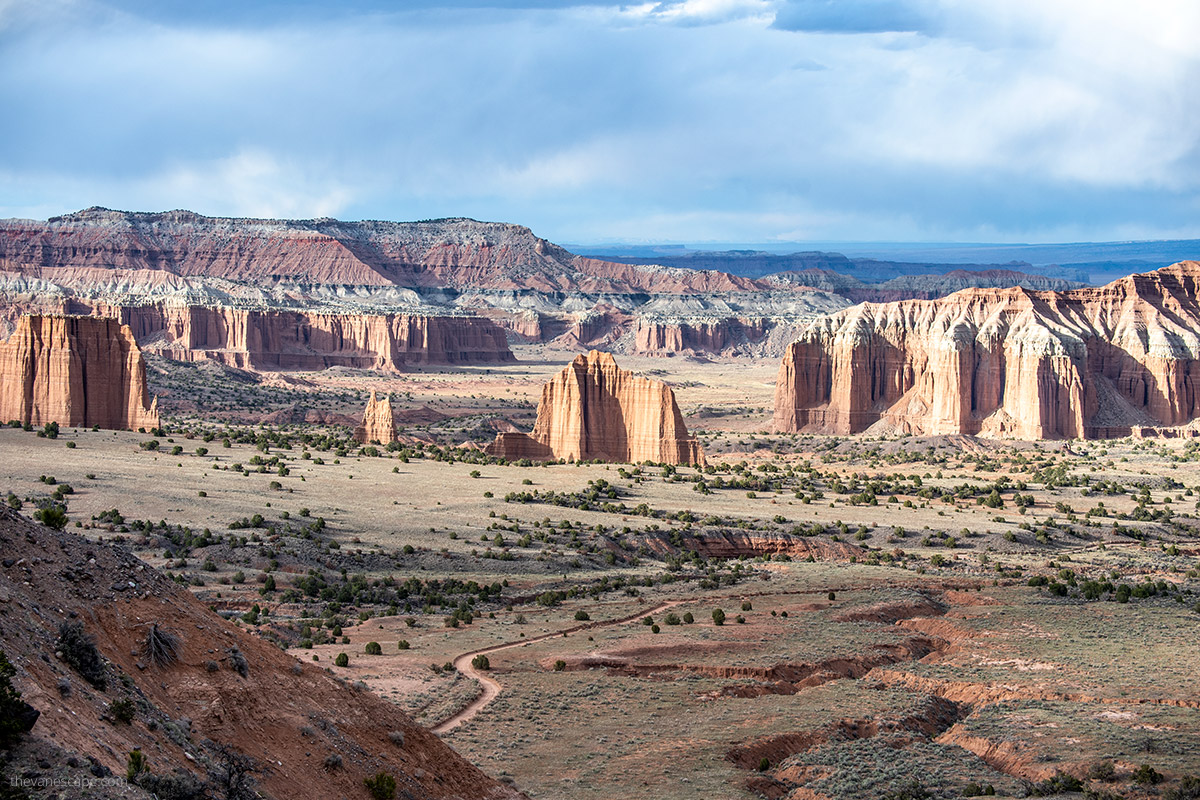
Introduction: Discover Cathedral Valley Loop
Cathedral Valley Loop is one of the most awe-inspiring yet lesser-known attractions in Capitol Reef National Park. Given the challenging access conditions, the requirement for a 4WD vehicle, and the necessity for seasoned off-road driving skills, Cathedral Valley Loop remains one of the least-visited spots in Capitol Reef National Park. The upside? You’ll find no crowds here, only the promise of some of Utah’s most stunning vistas as your reward.
In this ultimate guide to Cathedral Valley Loop, you will delve into a 58-mile journey through some of the most breathtaking landscapes in Capitol Reef National Park. You’re in the right place if you’re searching for an off-the-beaten-path adventure that offers solitude, natural beauty, and a dash of adrenaline. We provide detailed tips based on our personal experiences preparing to drive Cathedral Valley and what to expect in this rugged and remote district of Capitol Reef.
Make sure to visit the official park website for the latest conditions and alerts before your trip.
Quick Overview of Cathedral Valley in Capitol Reef
- Distance: 58 miles
- Time Required: 6-8 hours
- 4WD Required: Yes, strongly recommended
- Permit Required: No
- Fee Required: Yes
Cathedral Valley is a remote area within Capitol Reef National Park, renowned for its towering monoliths, expansive desert landscapes, and intricate geological formations. The loop itself is a 58-mile dirt road that typically takes about 6-8 hours to complete, depending on how many stops you make.
The route is best traveled in a clockwise direction to take advantage of the natural light for photography. A 4WD vehicle is essential for safely navigating rough terrain and river crossings.
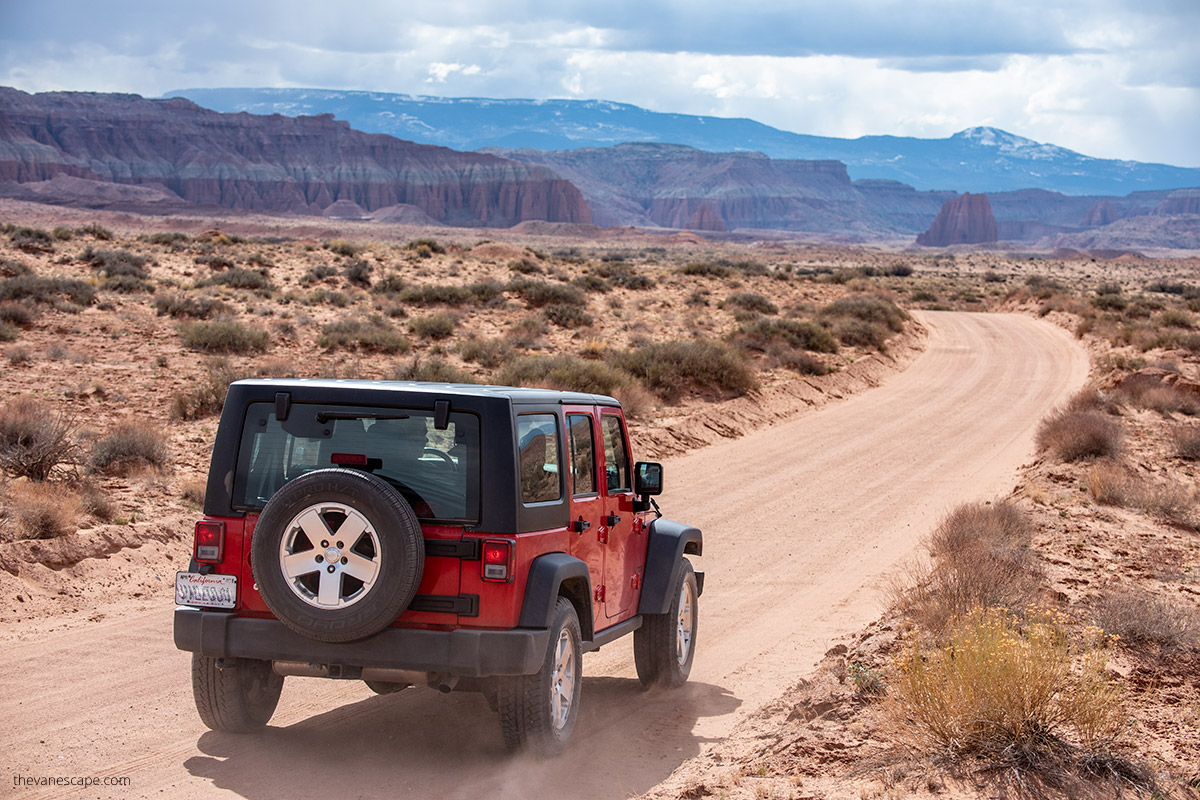
Why Our Guide is Unique: A Personal Journey
Our firsthand experience exploring the Cathedral Valley Loop sets this guide apart. We’ve clocked the miles, navigated the challenges, and captured the awe-inspiring vistas that make this trip a once-in-a-lifetime experience.
Chris and I made this loop during our Spring road trip. From practical advice to those “wow” moments you won’t find in a brochure, this guide is your comprehensive resource for all things Cathedral Valley in Capitol Reef.
If you plan your Utah National Parks Itinerary, add Cathedral Valley to your road trip.
If you’re an avid hiker, a photography enthusiast, or someone who loves the great outdoors, this guide is designed with you in mind. Moreover, if you want to see Cathedral Valley but don’t know if this drive is for you and are wondering if there are organized tours, we will tell you the best local Cathedral Valley Loop Tour.
The pictures we present in this article were taken during our road trip.
Our Tip: We also encourage you to read our other guides to Capitol Reef because the park has wholly enchanted us. So, if you’re considering a journey, check out How to Plan a Trip to Capitol Reef National Park, where we tell you the best months to go, where to stay, top attractions, and other helpful tips.
Also, check out our Capitol Reef National Park itinerary, where we suggest how to spend your time if you only have one day and what to do if you have three days in Capitol Reef. Have a look at the top things to do in Capitol Reef if you have more time to explore this area.
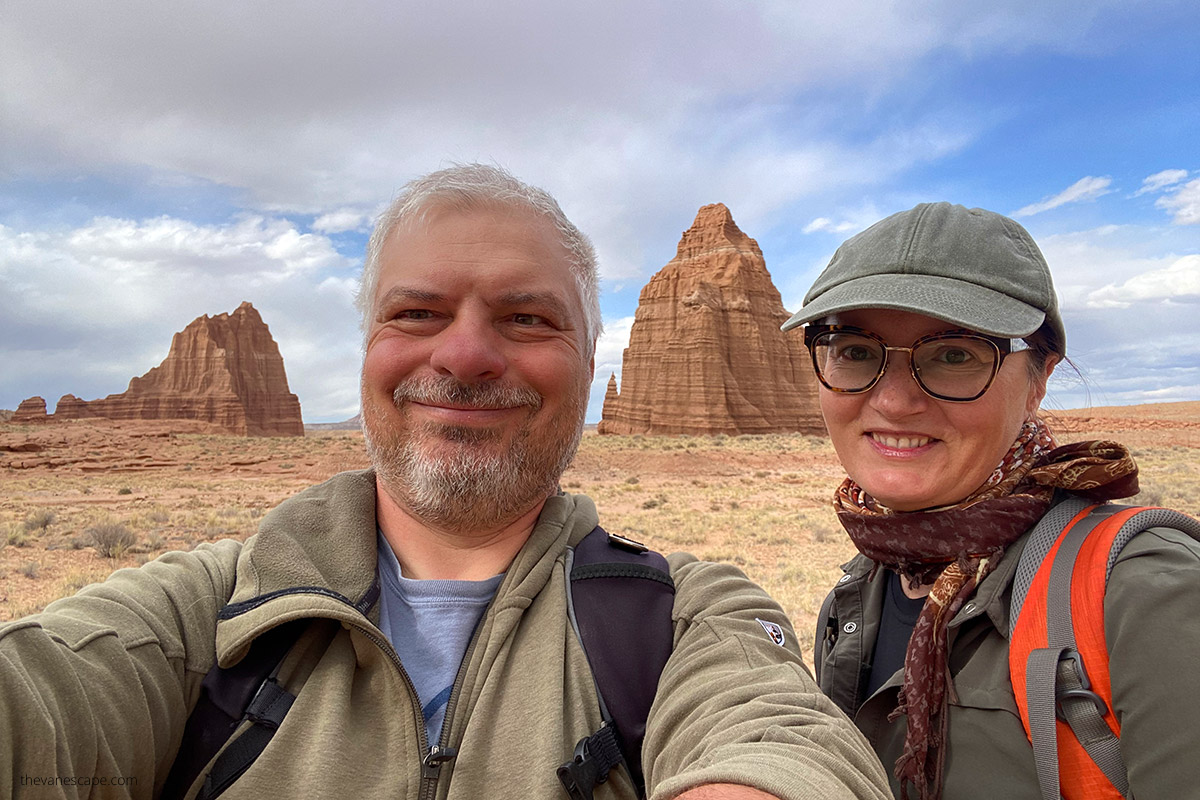
How to Get to Cathedral Valley Capitol Reef
Embarking on an adventure to Cathedral Valley Loop starts with getting to its location within the expansive Capitol Reef National Park. Be prepared for the journey because this route usually has no phone or Internet coverage. Make sure to purchase this detailed National Geographic Trails Illustrated Map of Capitol Reef, which includes Cathedral Valley Loop.
Driving Distances to Cathedral Valley Loop
Here are the approximate driving distances and times to Cathedral Valley Loop from various popular locations and outdoor towns in Utah. Please note that these are average estimates and can vary.
- From Fruita, UT: Distance: 60 miles, Time: 1 hour 15 minutes
- Moab, UT: Distance: 150 miles, Time: 2 hours 45 minutes
- From Kanab: Distance: 250 miles, Time: 4 hours 30 minutes
- Escalante: Distance: 120 miles, Time: 2 hours 30 minutes
- From Bryce Canyon National Park: Distance: 125 miles, Time: 2 hours 45 minutes
- Canyonlands National Park: Distance: 175 miles, Time: 3 hours 15 minutes
- From Arches National Park: Distance: 155 miles, Time: 2 hours 50 minutes
- Zion National Park, Distance: 275 miles, Time: 5 hours
Directions to Cathedral Valley Loop
The primary access point to Cathedral Valley Loop is Hartnet Road, which branches off Utah State Route 24. If you’re coming from the west, take Route 24 eastward from Torrey. If you’re approaching from the east, you’ll be traveling westward from Hanksville. Once on Hartnet Road, follow the signs leading to Cathedral Valley.
The loop is a 57.6-mile circuit that most explorers prefer to navigate in a clockwise direction. Here’s how to get there and what to expect:
Starting Your Journey
Begin your adventure on Hartnet Road, which is approximately 11 miles east of the Capitol Reef Visitor Center along Highway 24. Continue on Hartnet Road for about 28 miles until you reach a junction called Hartnet Junction.
Making the Turn
At Hartnet Junction, make a right turn heading north onto Cathedral Road. Follow this road for nearly 30 miles, eventually leading you back to Highway 24, completing your loop.
Crossing the Fremont River
It’s important to note that the southern end of Hartnet Road near Highway 24 involves crossing the Fremont River. There’s no bridge here, so you’ll have to ford the river. This should only be attempted when water levels are low, typically less than a foot deep, and the riverbed is hard and rocky.
Private Land and No Trespassing
The road leading to the river crossing traverses private property. Please respect the “No Trespassing” signs on the road near the Ford. Avoid parking off-road or camping in this area to honor the private land boundaries.
Cathedral Valley Loop Map
If you’re in search of a Cathedral Valley Loop Map, you’ve got three options to choose from.
- First, grab a complimentary PDF map from the official park website.
- Second, swing by the Visitor Center in Fruita to collect a free brochure with the Cathedral Valley Loop Map.
- Lastly, you can invest in a Trails Illustrated Map by National Geographic, which covers Capitol Reef National Park and includes details on the Cathedral Valley Loop. This topographic map is your ultimate guide to exploring Utah’s red rock wonderland. The map also features a handy summary chart for Fruita day hikes, safety tips, and more. It has an entire UTM grid for GPS navigation, printed on durable, waterproof, and tear-resistant paper. From scenic viewpoints to campgrounds, this map has everything you need for your Capitol Reef adventure.
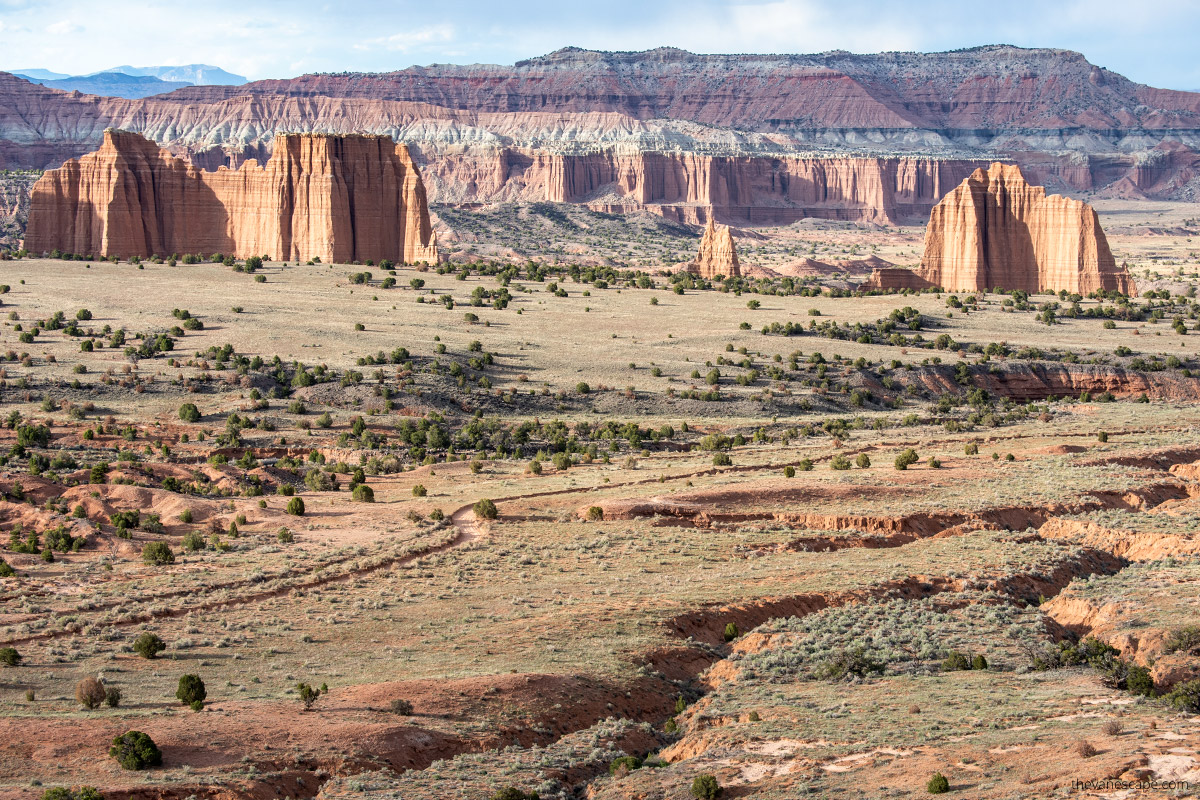
Best Seasons to Visit Cathedral Valley
Cathedral Valley is accessible year-round, but the best times to visit are during the spring and fall when the weather is milder. Summer can be extremely hot, and winter conditions can make the roads impassable.
However, spring and summer storms can temporarily make the roads in Cathedral Valley impassable, even for a 4×4, due to stream crossings and rough clay terrain. Flash floods are possible during monsoon season. Make sure to check this detailed weather forecast for Cathedral Valley. Here’s a breakdown of what to expect each season.
Spring (March to May)
- Average Temperatures: Highs of 60-70°F, lows of 30-40°F.
- Rain and Streams: Occasional rain showers; stream levels moderate.
- Notes: Spring offers mild temperatures and blooming desert flora, making it one of the best times to visit. However, be cautious of rain forecasts as even moderate rain can make the dirt roads slippery and streams harder to cross.
Summer (June to August)
- Average Temperatures: Highs of 85-95°F, lows of 55-65°F.
- Rain and Streams: Monsoon season in late summer; flash floods possible.
- Notes: Summer can be scorching and is also the monsoon season, which can lead to flash floods. If you choose to visit during this time, be prepared for extreme conditions and always check weather forecasts.
Fall (September to November)
- Average Temperatures: Highs of 70-80°F, lows of 40-50°F.
- Rain and Streams: Minimal rainfall; stream levels low to moderate.
- Notes: Fall is another excellent time to visit, with pleasant temperatures and lower chances of rain. Stream levels are generally manageable, making it easier to navigate the loop.
Winter (December to February)
- Average Temperatures: Highs of 40-50°F, lows of 10-20°F.
- Rain and Streams: Snow and ice are possible; streams may freeze.
- Notes: Winter is the least advisable time to visit due to potential snow and ice on the roads. If you’re an experienced winter driver and are prepared for the conditions, it can offer solitude and unique snowy landscapes.
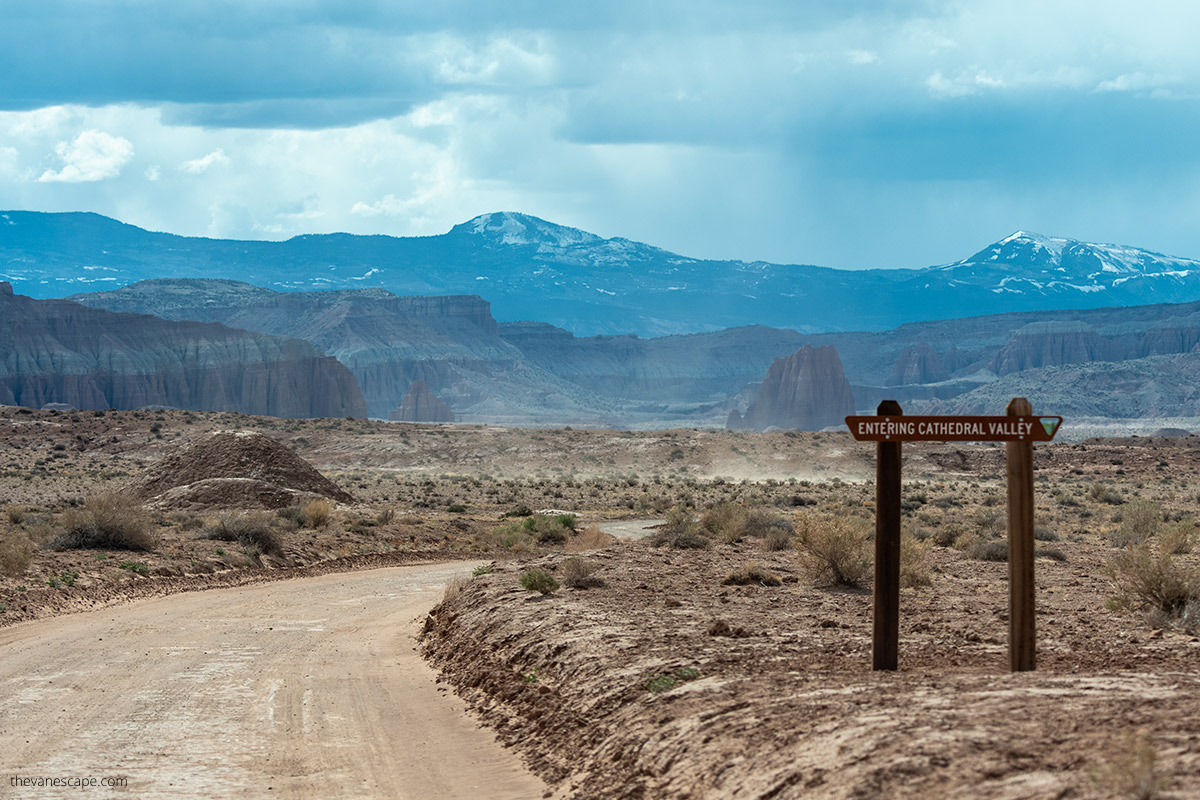
Preparation, Safety, and 4WD Requirements
Embarking on a journey through Cathedral Valley Loop isn’t your typical Sunday drive. The route demands preparation, awareness, and the right kind of vehicle. You need to know here to ensure a safe and enjoyable adventure.
Our Tip: It’s a great idea to check the road condition at the visitor center in Fruita or call 435-425-3791. Press #1 for information and then #4 for current road conditions. For weather conditions, press #3, or check this website.
4WD: A Must-Have for Cathedral Valley Loop
A 4WD vehicle is not just recommended; it’s essential. The loop includes challenging terrains like rough clay, rocky paths, and stream crossings that can become hazardous, especially after rain. Make sure your vehicle is in excellent condition and equipped for off-road driving.
We opted for a Jeep Wrangler from Alamo rental on our adventure, which didn’t disappoint. Given the challenging terrain, the vehicle’s performance was impeccable. Chris’ expertise in navigating gravel roads was the cherry on top, making our journey possible.
Essential Packing List for Cathedral Valley Loop Drive
- Navigation: Pack a physical detailed map of Capitol Reef, which includes the Cathedral Valley Loop. There is no internet or phone coverage on this terrain.
- Food and Water: At least one gallon of water per person and non-perishable snacks.
- First Aid Kit: Basic supplies to treat minor injuries.
- Communication: A fully charged phone and possibly a satellite phone for emergencies.
- Clothing: Weather-appropriate attire and extra layers.
- Vehicle Supplies: Spare tire, jack, and basic tools.
Safety Precautions and Emergency Info
- Weather Check: Always check the weather forecast before you set out. Spring and summer storms can make the roads impassable, even for a 4×4.
- Stream Levels: Be cautious of stream levels, especially at the Fremont River crossing. Do not attempt to cross during floods or high water periods.
- Emergency Contacts: Keep a list of emergency numbers, including the nearest ranger station.
- Itinerary: Inform someone of your plans and expected return time, as cell service is unreliable.
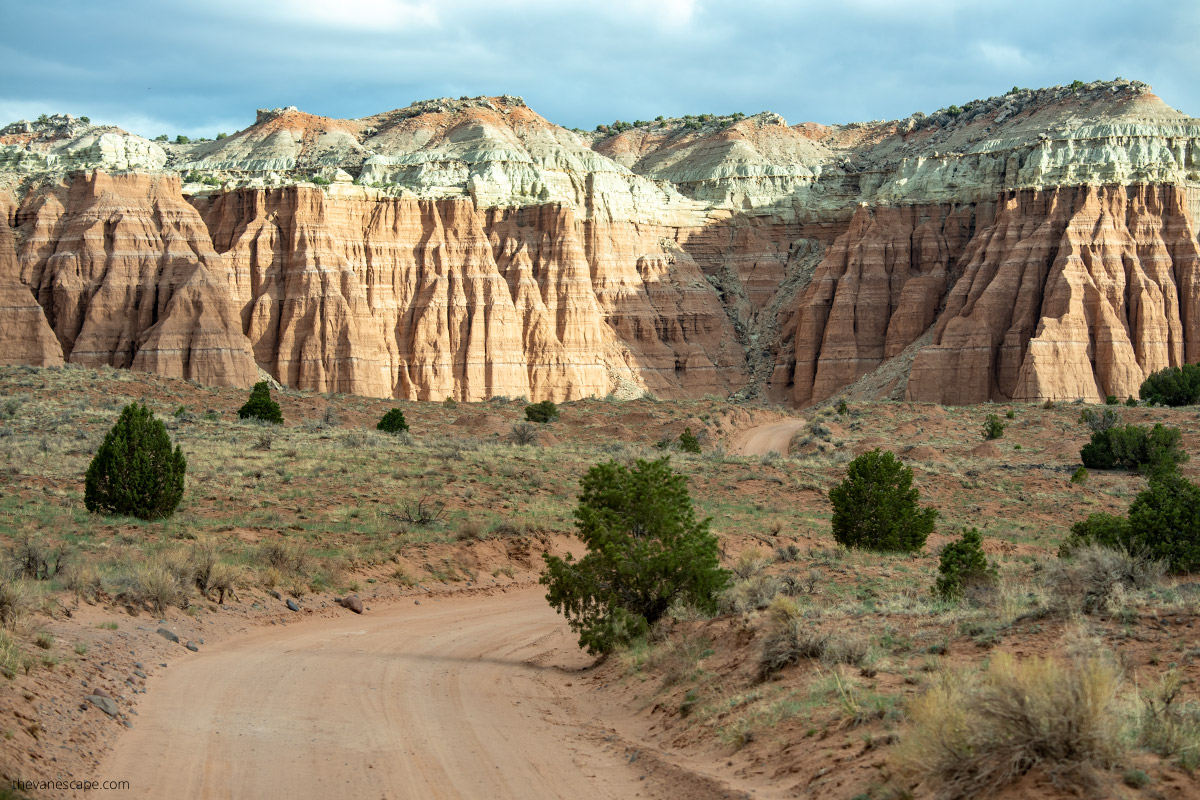
Cathedral Valley Loop in a Counter-Clockwise Direction
If you’re considering taking the Cathedral Valley Loop in a counter-clockwise direction, you should know a few things. This alternative route offers unique advantages, especially for photographers and those who might face challenges with the Fremont River crossing. We made this journey at the beginning of May, and it’s worth noting that the Fremont River crossing had deep water at that time.
If you’re pressed for time but still want to experience the awe-inspiring Temples of the Sun and Moon, we highly recommend tackling the Cathedral Valley Loop in a counter-clockwise direction. This route allows for quicker and easier access to these iconic formations, making it ideal for those who can’t commit to a full-day adventure. You’ll get to witness the grandeur of these natural wonders without the extended travel time, making your trip both efficient and unforgettable.
Why Go Counter-Clockwise?
Photography: The counter-clockwise direction is ideal for capturing the Temples of the Sun and Moon at sunrise and early morning. It also allows for better afternoon shots from the Lower Cathedral Valley Overlook.
Fremont River: If the Fremont River is too high to cross safely, you’ll find out at the end of your drive, allowing you to backtrack or take alternative routes without wasting time.
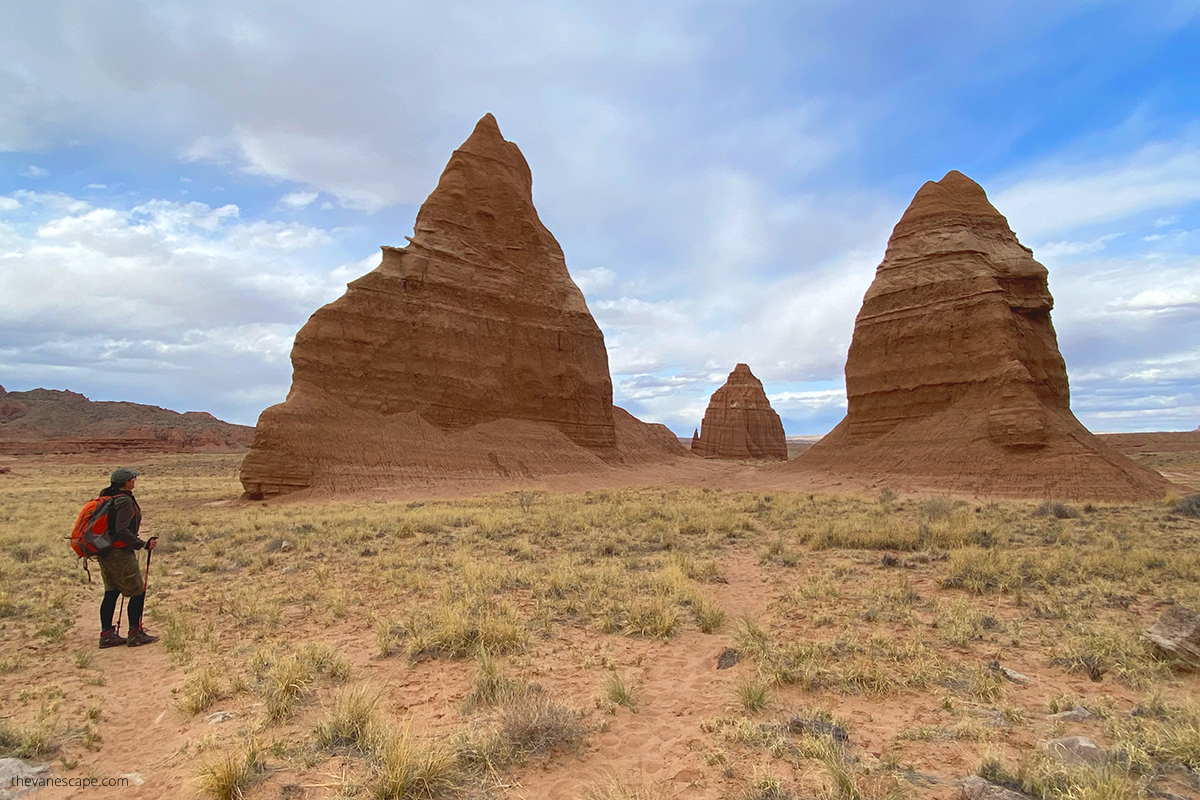
Key Stops in Counter-Clockwise Direction
- Historical Stop (6.0 miles): An old drilling truck and well are located here, remnants from when the area was a ranch.
- Bentonite Hills (8.6 miles): These colorful hills mix clay and volcanic ash. Be cautious if it has recently rained, as the area can become impassable.
- Lower South Desert Overlook & Jailhouse Rock (14.8 miles): A short spur road leads to an overlook, offering one of the best views along the drive.
- Lower Cathedral Valley Overlook (19.3 miles): A 1.8-mile round-trip hike takes you to an overlook for a bird’s-eye view of the Temples of the Sun and Moon.
- Upper South Desert Overlook (28.6 miles): A 0.5-mile round-trip hike leads to a viewpoint with panoramic views of the South Desert.
- Cathedrals Trail (32.8 miles): This 2.5-mile easy hike offers stunning views of Cathedral Valley’s sandstone formations.
- Gypsum Sinkhole (35.6 miles): A short walk from the parking area takes you to this large sinkhole formed by dissolving gypsum.
By going counter-clockwise, you can optimize your time and photography while having a backup plan in case of impassable river conditions.
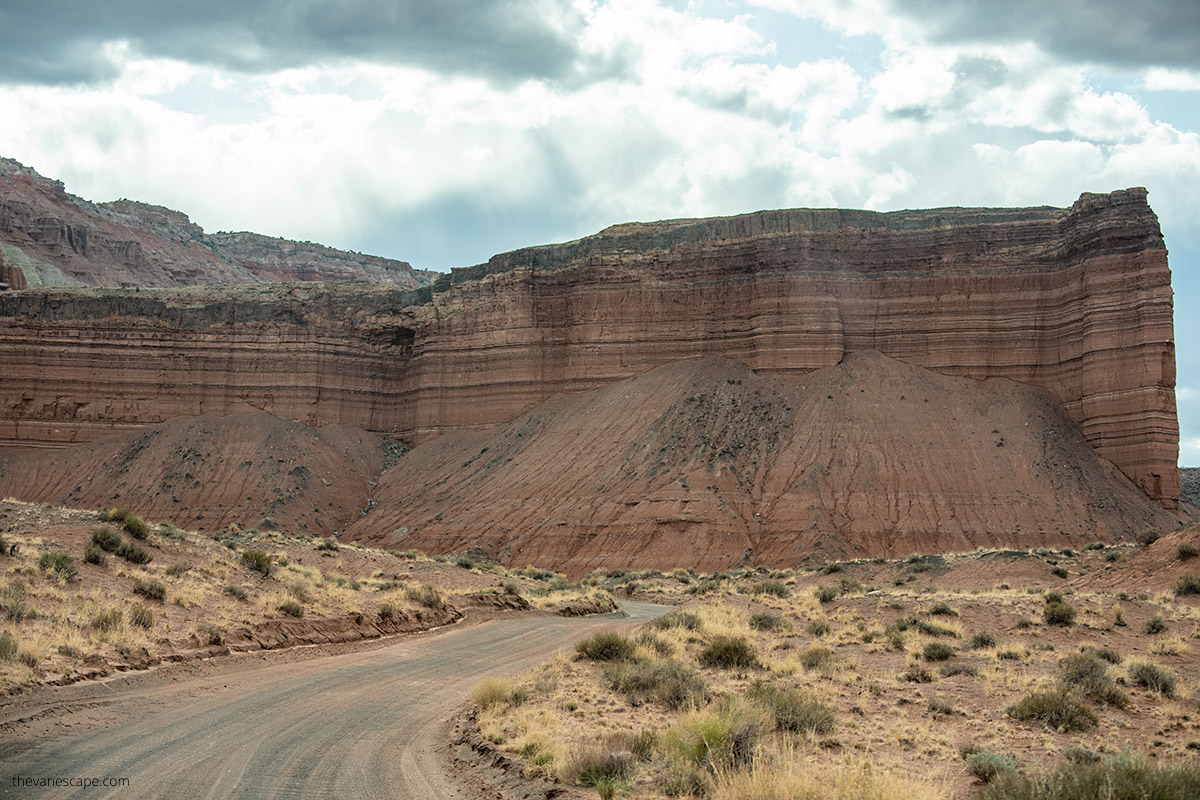
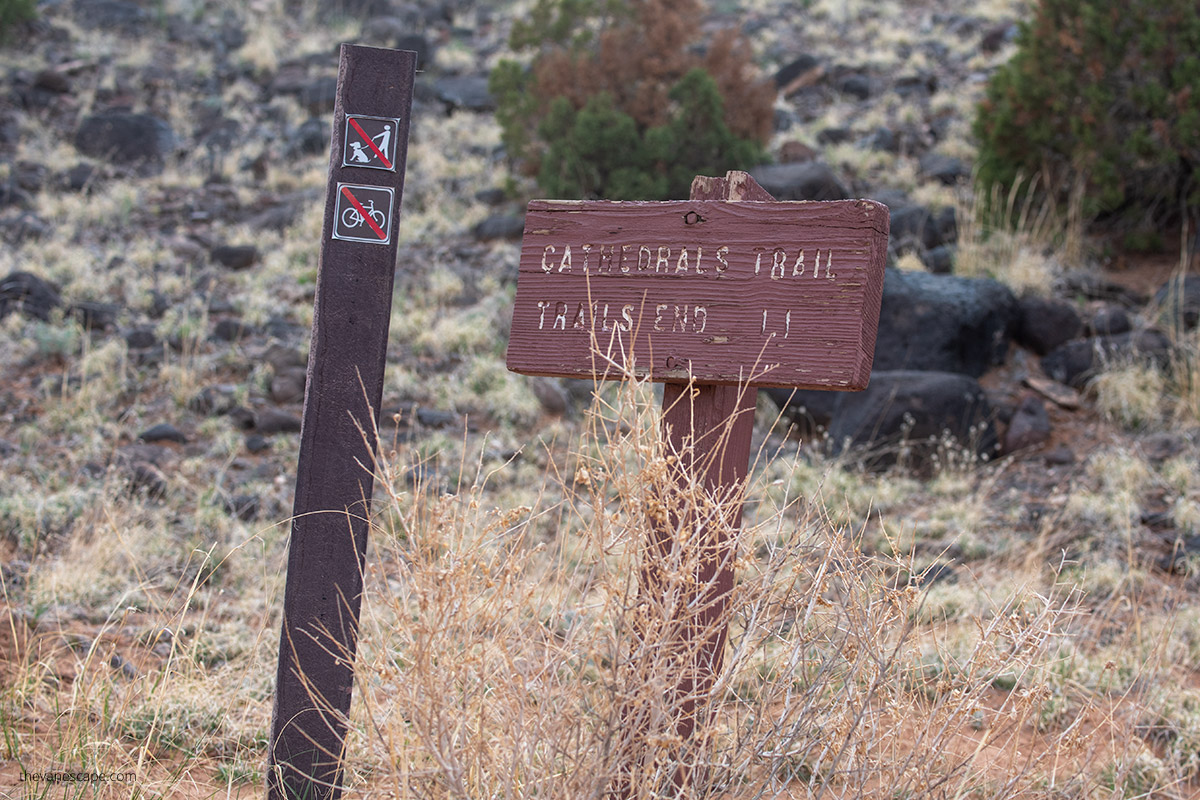
Cathedral Valley Loop – Best Stops in Clockwise Direction
If you opt for the clockwise direction, the route offers its own set of unique experiences and viewpoints. The advantage of going this way is that you tackle the Fremont River crossing at the very beginning, allowing you to assess whether it’s safe to continue or if you need to modify your plans.
The clockwise direction offers a different lighting perspective for photography, especially at the Lower Cathedral Valley Overlook and the Temples of the Sun and Moon. It’s a route worth considering for those looking to capture the beauty of Cathedral Valley from a different angle.
Key Stops in Clockwise Direction
Start at Hartnet Road: Just like in the counter-clockwise direction, you’ll start at Hartnet Road and make your way to the Fremont River crossing.
- Historical Stop: This is the same as in the counter-clockwise direction, offering a glimpse into the area’s ranching past.
- Bentonite Hills: These hills are a colorful spectacle, and you’ll encounter them early on in your journey.
- Lower South Desert Overlook & Jailhouse Rock: This overlook offers panoramic views and is one of the highlights of the drive.
- Park Boundary: You’ll enter Capitol Reef National Park, marking the official start of your adventure within the park.
- Lower Cathedral Valley Overlook: A hike here offers a bird’s eye view of the Temples of the Sun and Moon, and it’s best visited in the afternoon for optimal lighting.
- Upper South Desert Overlook: This overlook provides stunning views of the South Desert and the Water Pocket Fold.
- Upper Cathedral Valley Overlook: A short detour will lead you to this overlook, offering views of Cathedral Valley’s sandstone monoliths.
- Cathedral Valley Campground: This is your only chance for a restroom break, so make the most of it.
- Morrell Cabin: This cabin offers a historical perspective on the area.
- Cathedrals Trail: This trail offers the best views of Cathedral Valley’s monoliths.
- Gypsum Sinkhole: This unique geological feature is worth a quick visit.
- Exit Capitol Reef National Park: You’ll exit the park and reenter BLM lands.
- Temples of the Sun and Moon: These iconic formations are a must-see and offer excellent photo opportunities.
- Glass Mountain: This mound of selenite crystals is a unique feature on the route.
- End of Loop: You’ll complete the loop and reach Highway 24.
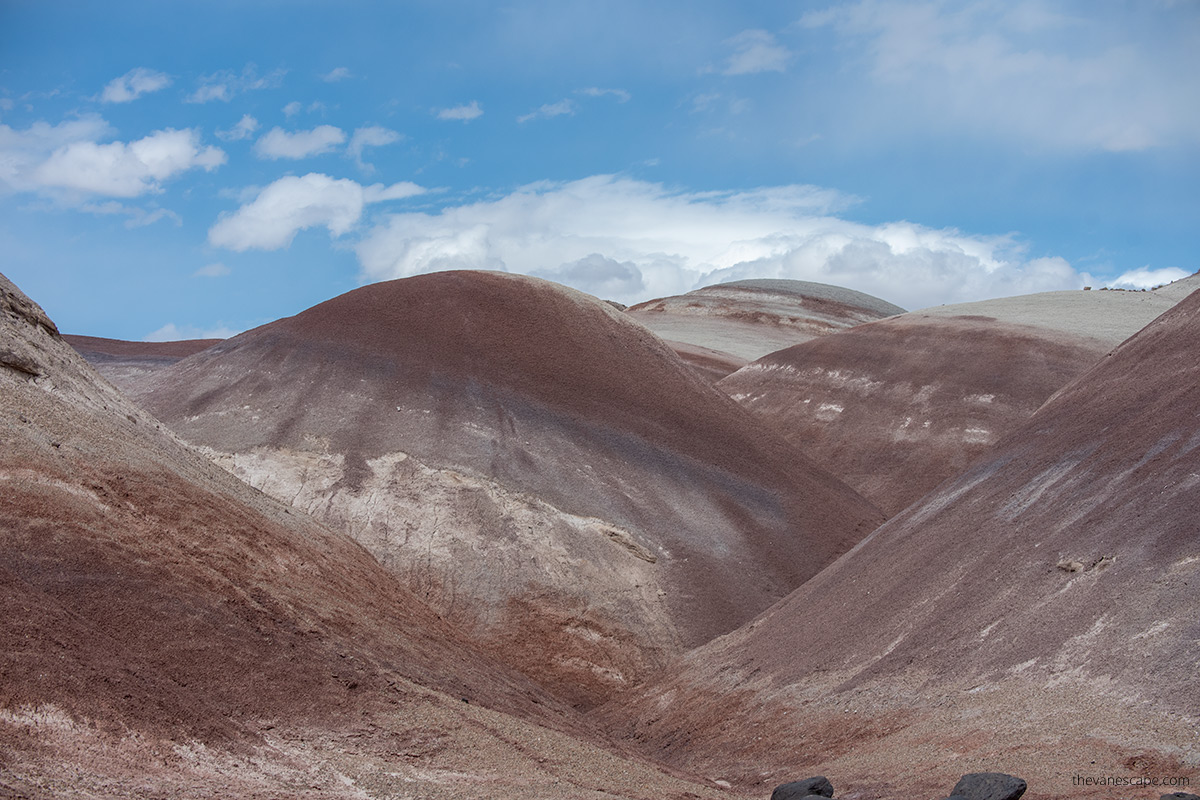
Must-See Attractions on Cathedral Valley Loop
Cathedral Valley Loop is not just a road; it’s a gateway to some of Utah’s most awe-inspiring natural wonders. From towering monoliths to colorful hills, the loop offers a variety of sights that you can’t miss. Here’s our rundown of must-see attractions along the scenic way.
Temple of the Sun and Temple of the Moon
These iconic sandstone monoliths are the crown jewels of Cathedral Valley. The Temple of the Sun is particularly stunning during sunrise, while the Temple of the Moon is a sight to behold as the sun sets. Their grandeur and solitude make them a photographer’s dream and a hiker’s delight.
Bentonite Hills
A colorful landscape that comes alive, especially after a rainstorm. The vibrant hues of these hills are a photographer’s dream. Similar in colors are rock formations known as the Paria Rainbow Mountains. However, the Paria Rainbow Mountains and the Bentonite Hills in Utah are two distinct geological features with different formations, compositions, and locations.
Gypsum Sinkhole
This sinkhole offers a fascinating geological feature that offers a quick but intriguing stop to observe the area’s diverse geology.
Glass Mountain
Made up of large selenite crystals that shimmer in the sunlight, this unique formation is worth the small detour off the main loop.
Lower South Desert Overlook
Offering panoramic views of the Lower South Desert, this overlook is ideal for a picnic or to take in the expansive vistas.
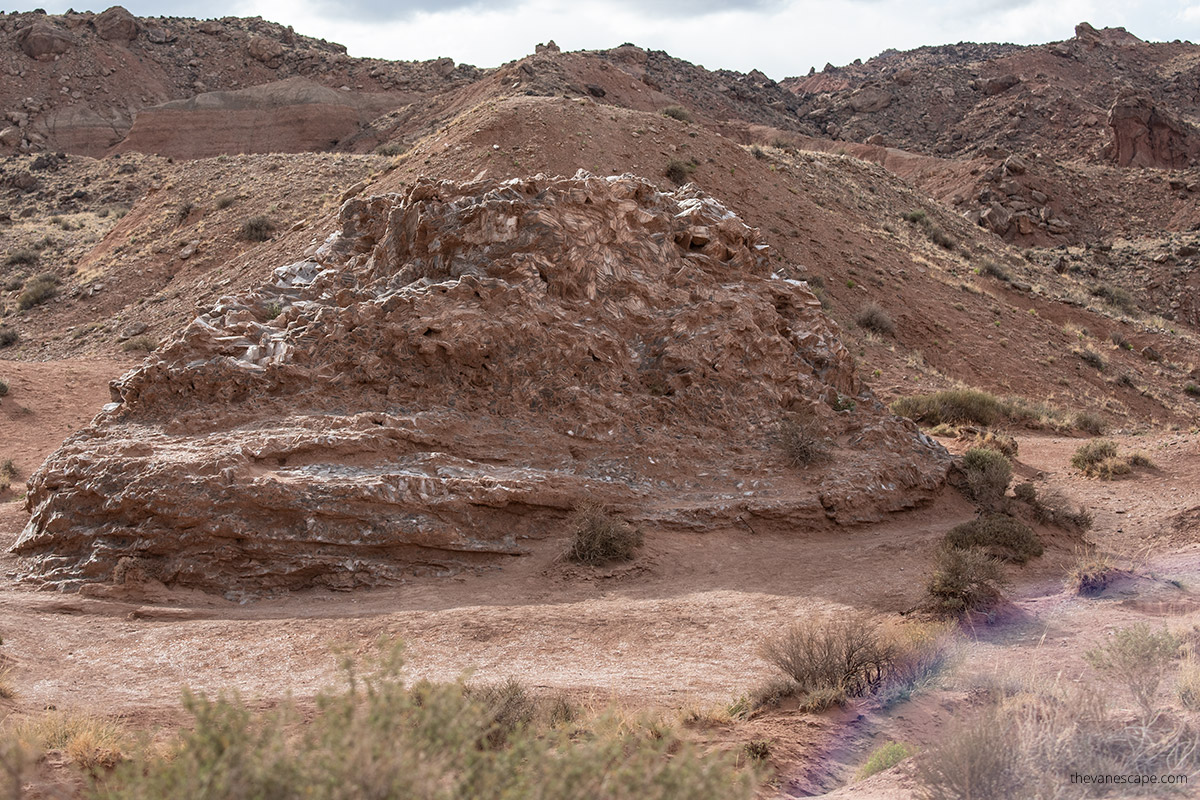
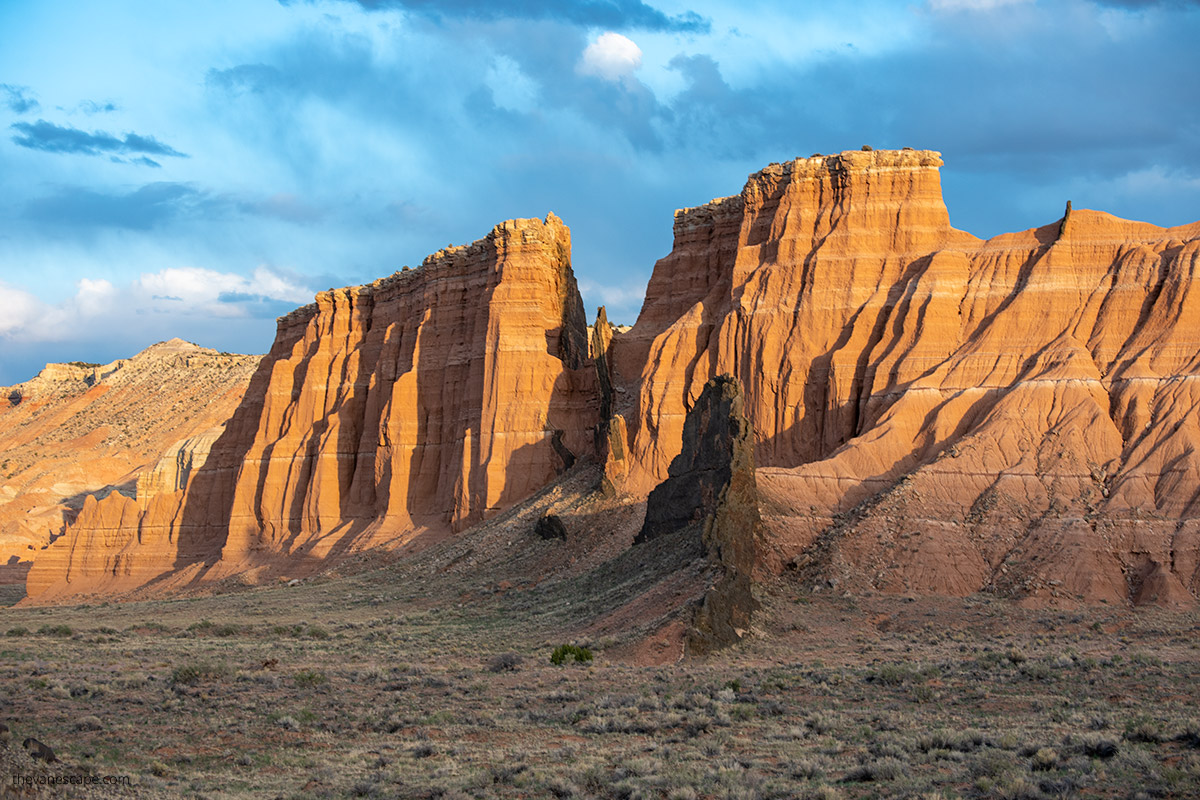
Upper South Desert Overlook
Similar to its lower counterpart but offers different angles and perspectives of the South Desert and beyond.
Upper Cathedral Valley Overlook
This overlook provides a breathtaking view of the Upper Cathedral Valley, showcasing the area’s stunning geology and formations.
Jailhouse Rock
A unique rock formation resembling the bars of a jailhouse, this attraction adds a whimsical touch to the Cathedral Valley experience.
The Fremont River Crossing
While not a traditional “attraction,” the river crossing is a memorable part of the Cathedral Valley Loop experience. It’s both a challenge and a thrill, especially if you’re navigating it for the first time.
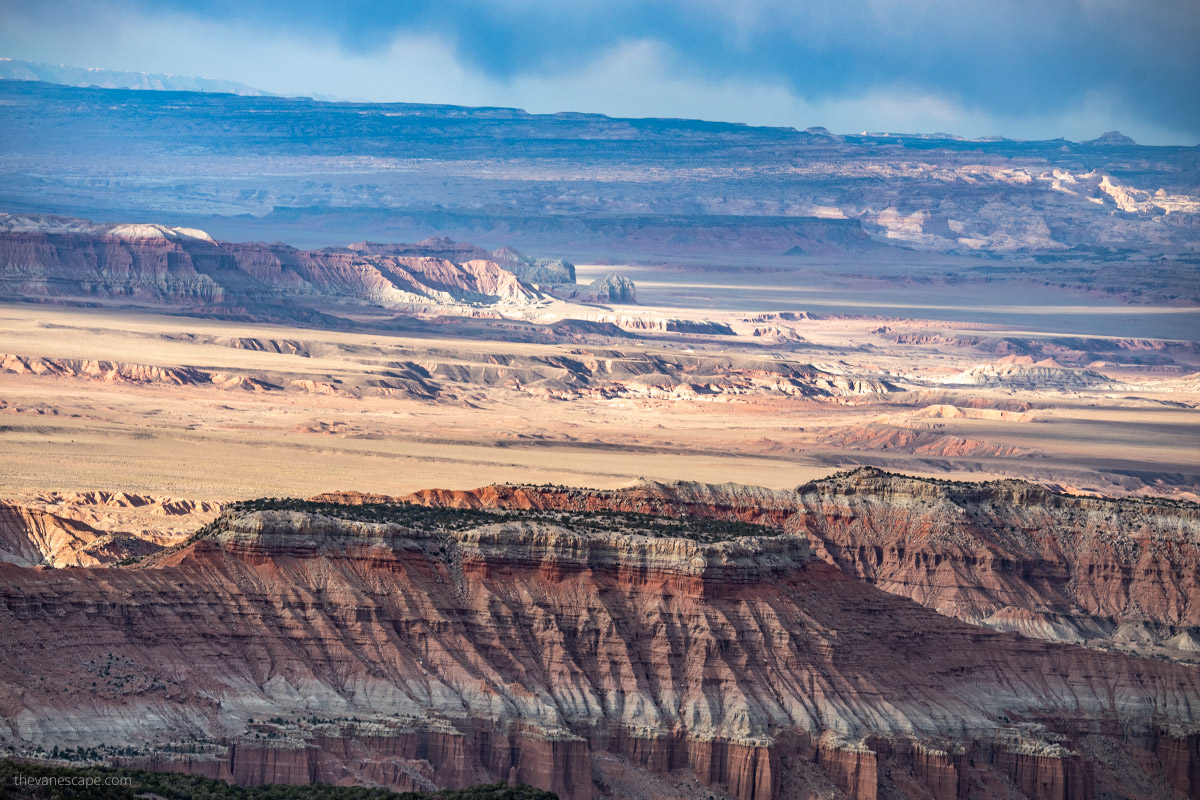
Hiking in Cathedral Valley
While Cathedral Valley Loop is primarily known for its scenic drive, it also offers some incredible hiking opportunities for those looking to stretch their legs and get up close to nature. Whether you’re a casual hiker or an experienced trekker, there’s a trail for you. While hiking, respect the natural environment by staying on designated paths and taking all trash with you. Here’s a guide to some of the best hikes in the area.
Cathedral Valley Overlook Trail
- Distance: 0.5 miles round trip
- Difficulty: Easy
- Highlights: This short hike takes you to the Upper Cathedral Valley Overlook, offering panoramic views of the valley’s iconic formations.
Temple of the Sun and Temple of the Moon Trail
- Distance: 1.5 miles round trip
- Difficulty: Moderate
- Highlights: This trail allows you to walk up close to these towering monoliths, providing a different perspective than the overlooks.
Lower South Desert Overlook Trail
- Distance: 0.8 miles round trip
- Difficulty: Easy
- Highlights: A short hike that leads to an overlook with sweeping views of the Lower South Desert.
Jailhouse Rock Trail
- Distance: 2 miles round trip
- Difficulty: Moderate
- Highlights: This trail takes you to the base of Jailhouse Rock and offers excellent opportunities for photography and bird-watching.
Bentonite Hills Loop
- Distance: 3 miles loop
- Difficulty: Moderate
- Highlights: This loop trail takes you through the colorful Bentonite Hills, offering multiple viewpoints and photo opportunities.
Safety Tips for Hikers in Cathedral Valley Capitol Reef
- Water: Always carry sufficient water, as there are no reliable water sources on the trails.
- Weather: Check the weather forecast before heading out, especially during the spring and summer when storms can make conditions hazardous.
- Footwear: Sturdy hiking boots are recommended for better grip and ankle support.
- Navigation: Carry a detailed paper map and compass or GPS, as some trails are not well-marked.
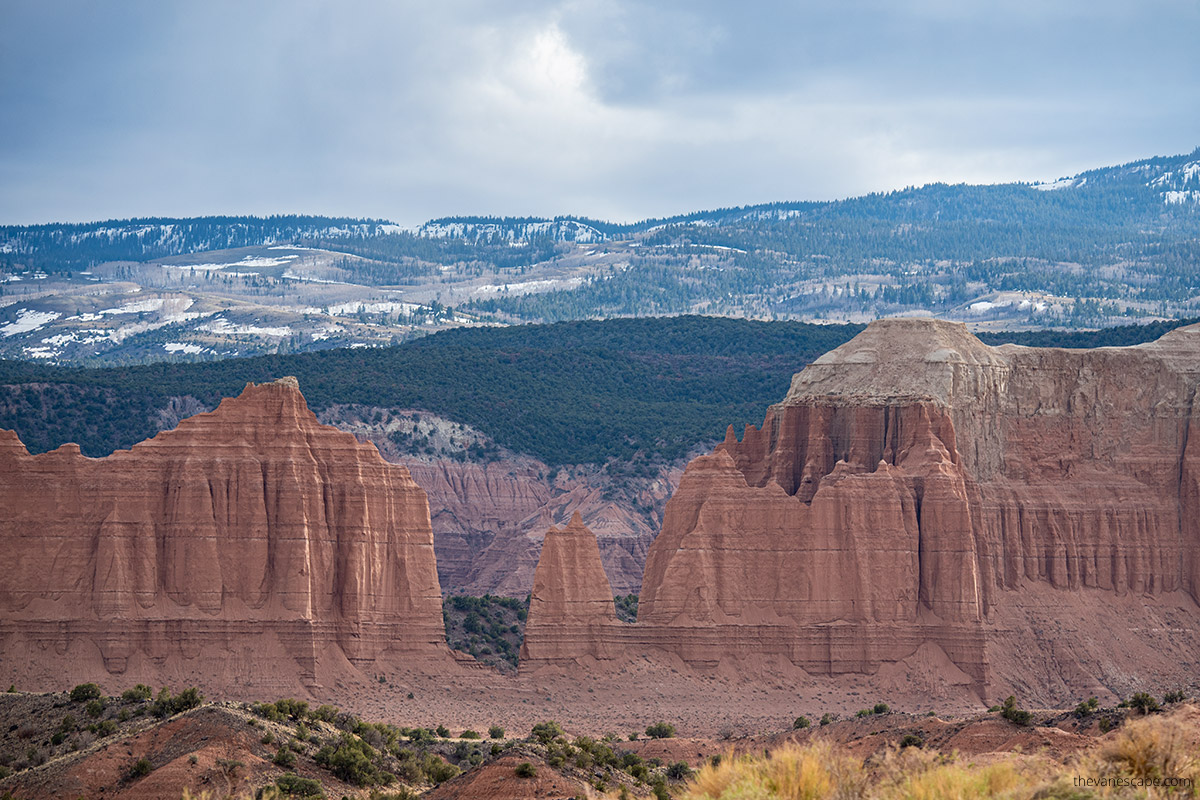
Accommodation and Camping in Cathedral Valley
While Cathedral Valley Loop offers a remote and rugged experience, there are still options for those looking to extend their stay overnight. Whether you’re interested in camping under the stars or seeking nearby accommodation, here’s what you need to know.
Cathedral Valley Campground
If you’re looking to immerse yourself in the natural beauty of Cathedral Valley, the Cathedral Valley Campground is your go-to spot. Situated roughly halfway along the Cathedral Valley Loop Road, this primitive campground offers a true backcountry experience.
The campground sits at an elevation of about 7,000 feet, surrounded by the Pinyon/Juniper-clad foothills of Thousand Lake Mountain. It is a pretty windy area, and temperatures drop significantly at night, so be prepared for a cold night at the campsite and pack warm things.
Our Tip: Remember to follow the Leave No Trace rules while camping and exploring Capitol Reef National Park.
Amenities and Facilities
The Cathedral Valley Campground has six sites, each equipped with a picnic table and fire grate. While there’s a pit toilet available, you won’t find any water sources, so make sure to bring plenty of your own. Fires are only permitted within fire rings in designated campgrounds. Collecting or damaging any park resources is strictly prohibited.
Accessibility and Conditions
High-clearance four-wheel-drive vehicles are generally required to reach Cathedral Valley Campground. It’s open year-round but can become inaccessible due to weather conditions. Always check the current road conditions and weather.
Reservations
No reservations are needed; it’s on a first-come, first-served basis. So, if you’re looking for solitude and are well-prepared, this could be your ideal camping spot.
Backpacking and Backcountry Camping
If you’re up for a more adventurous experience, backcountry camping is also an option. However, free permits are required and can be obtained in person at Capitol Reef Visitor Center. Make sure to read Backcountry Regulations.
Cedar Mesa Campground
Another option is the Cedar Mesa Campground, located about 23 miles south of Utah State Highway 24 on the Notom-Bullfrog Road. That’s quite a distance from Cathedral Valley. This campground also offers a primitive, no-fee experience with five sites, each having a picnic table and fire grate. Unlike Cathedral Valley Campground, Cedar Mesa is usually accessible by two-wheel-drive vehicles, depending on road conditions.
Nearby Accommodations
While Cathedral Valley itself is remote, the nearby towns of Torrey and Hanksville offer a range of accommodations, from motels to bed and breakfasts. These towns are within an hour’s drive from the loop, making them convenient bases for your adventure. Consider Capitol Reef Resort, or The Rim Rock Inn. Below you can check the best deals.
Photography in Cathedral Valley Capitol Reef
Cathedral Valley in Capitol Reef National Park is a photographer’s paradise, offering a unique blend of towering monoliths, expansive desert landscapes, and dramatic skies. Whether you’re a professional photographer or a hobbyist, this guide will help you capture the essence of Cathedral Valley’s breathtaking beauty.
Best Times for Photography
- Golden Hour: The soft, golden light during sunrise and sunset creates a magical atmosphere, perfect for capturing the Temples of the Sun and Moon.
- Blue Hour: The period just before sunrise and after sunset offers a cool, serene light that contrasts beautifully with the warm tones of the desert landscape.
Key Photography Spots in Cathedral Valley
- Temple of the Sun and Temple of the Moon (Mile Marker 42): These iconic formations are a must-visit for any photographer. The play of light and shadow on these structures is mesmerizing.
- Upper Cathedral Valley Overlook (Mile Marker 27.4): This spot provides a panoramic view of the Upper Cathedral Valley, perfect for wide-angle shots.
- Jailhouse Rock (Mile Marker 50): This unique rock formation offers excellent opportunities for both close-up and landscape photography.
- Upper South Desert Overlook (Mile Marker 27.1): Capture the expansive desert framed by steep cliffs and the distant Henry Mountains.
- Lower South Desert Overlook (Mile Marker 15.2): This overlook offers a different perspective of the South Desert, ideal for capturing its vastness.
Cathedral Valley Photography Tips
- Equipment: A tripod is essential for long-exposure shots, especially during the golden and blue hours.
- Lenses: Wide-angle lenses are great for landscapes, while telephoto lenses can help you capture distant details.
- Filters: Consider using polarizing or ND filters to manage reflections and light exposure.
- Weather: Always check the weather forecast. Storm clouds can add drama to your photos but can also make the roads impassable.
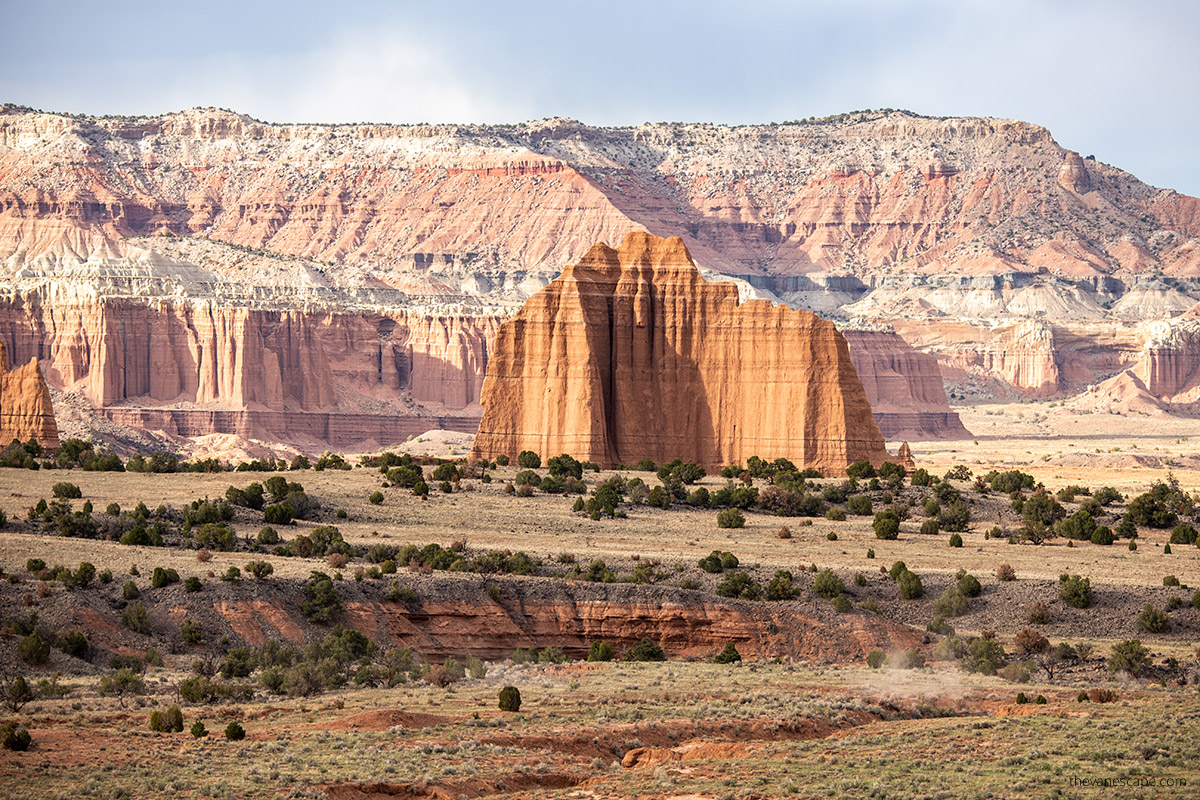
Insider Tips for Driving Cathedral Valley Loop
Cathedral Valley Loop is a journey through some of Utah’s most stunning landscapes, but like any adventure, knowing a few insider tips can make your experience even more memorable. Here’s what you should know before hitting the road.
Timing is Everything
- Early Start: The loop takes about 6-8 hours to complete without stops. Starting early not only helps you avoid the heat but also gives you ample time for exploration.
Know Your Vehicle
- Gas Up: The nearest gas stations are in Torrey or Hanksville. Make sure to fill it up before you start.
- Tire Check: Given the rugged terrain, ensure your tires are in good condition and that you have a spare.
Pack Smart
- Snacks and Hydration: No food or water sources are along the loop. Pack enough snacks and water to last the entire trip.
- Camera Gear: Don’t forget extra batteries and memory cards. You’ll be taking lots of photos!
Best Photo Ops
- Sunrise at Temple of the Sun: Arrive early to capture the first rays of sunlight illuminating this iconic monolith. Sunset is also stunning in this area.
- Stargazing at Cathedral Valley Campground: With minimal light pollution, the campground offers a celestial show you won’t want to miss.
Off-the-Beaten-Path Spots
- Morrell Cabin: This historic cabin is a short detour off Hartnet Road and offers a glimpse into the area’s past.
- The Walls of Jericho: Less frequented but equally stunning, these towering cliffs are worth the extra drive.
Safety First
- Weather Updates: Always check the weather forecast, especially if you plan to cross streams. Flash floods are a real danger.
- Emergency Kit: In addition to a first-aid kit, carry emergency supplies like a fire starter, blanket, and a whistle.
Respect the Environment
- Leave No Trace: Pack out what you pack in and stay on designated trails to protect the fragile desert ecosystem.
- Wildlife Awareness: Keep safe from wildlife and never feed the animals.
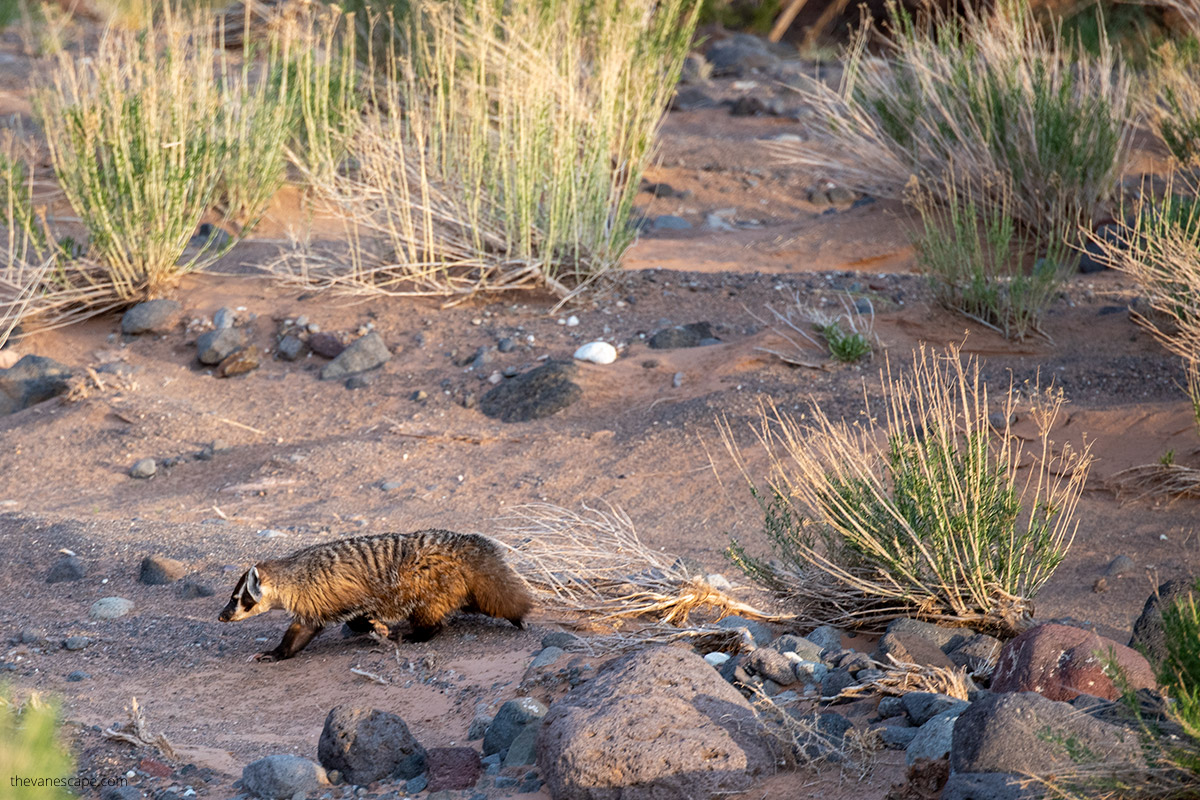
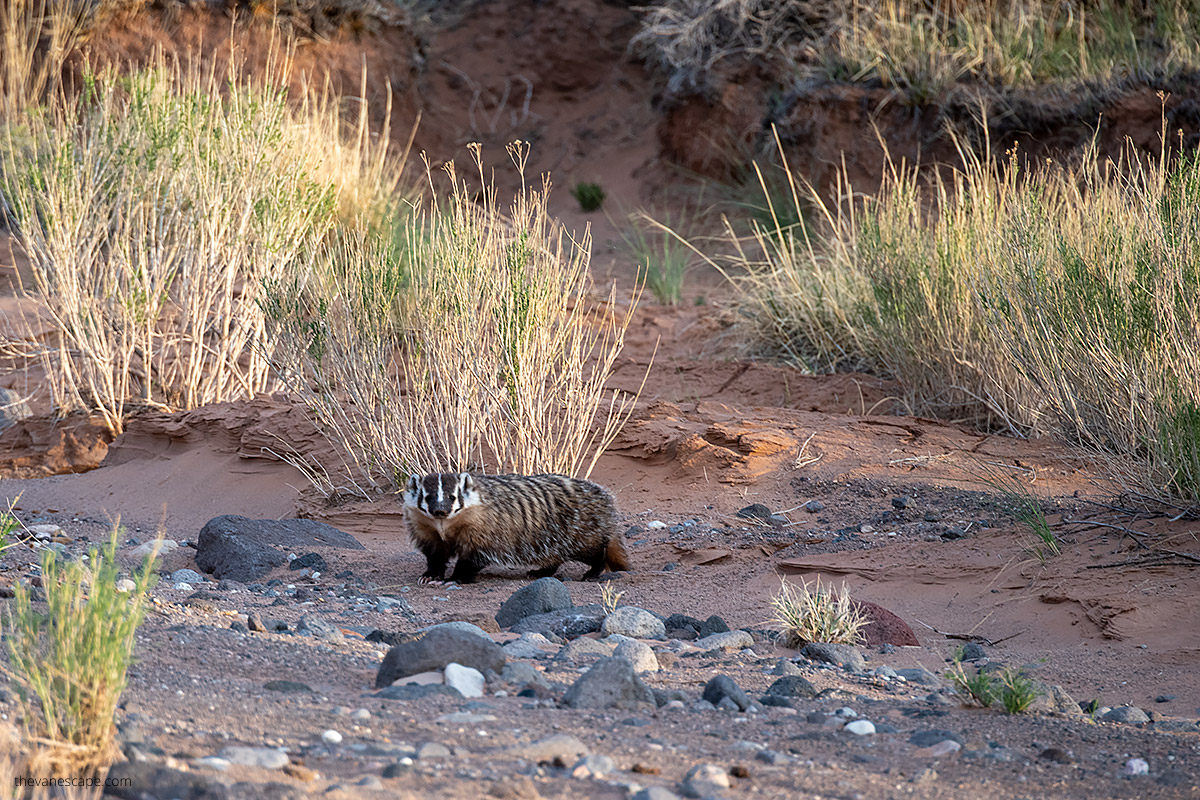
Cathedral Valley Loop Tour
If the idea of navigating the rugged terrains of Cathedral Valley Loop on your own feels daunting, or if you don’t have access to a 4×4 vehicle—don’t worry! There are several guided tours organized by local companies that take the hassle out of planning and ensure a safe, enriching experience.
We’ve done the research and can confidently recommend the best of the bunch: the Full-Day Private Off-Road Tour in Capitol Reef National Park. Read on to discover why this tour is your ticket to an unforgettable adventure.
Full-Day Private Off-Road Tour in Capitol Reef
Unleash your adventurous spirit with this Full-Day Private Off-Road Tour in Capitol Reef National Park! Kick off the day with a luxury SUV pick-up at your lodging and buckle up for a 70-mile journey through Utah’s untamed beauty. Traverse the dramatic Cathedral Valley Loop with a river crossing and awe-inspiring scenic stops. Your day is filled with wonder moments—from the rainbow-striped Bentonite Hills to the towering monoliths at Upper Cathedral Valley Overlook.
But that’s not all! Get close to iconic landmarks like Jailhouse Rock and the Temple of the Moon, guided by experts who’ll show you the best spots for that perfect shot. And when you think you’ve seen it all, the Glass Mountains appear, shimmering in the afternoon sun.
Refreshments, lunch stops, and a deep dive into the area’s rich history make this more than just a tour—it’s an adventure you’ll never forget.
Note: This tour is a private activity. This tour is not recommended for travelers with back problems, heart conditions, or severe medical issues. It’s also not suitable for pregnant travelers or those who are visually impaired. Only service animals are allowed.
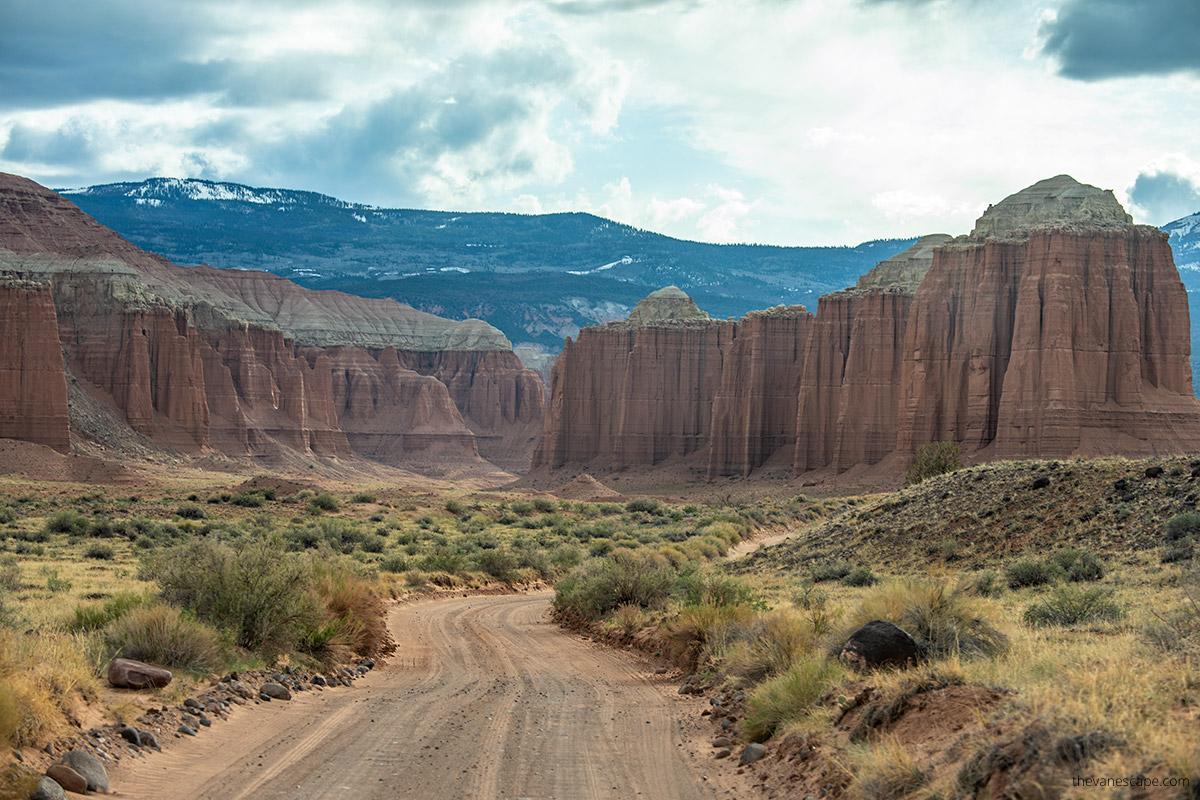
3-4 Hours Capitol Reef’s Cathedral Valley Jeep Tour
If you’re short on time but still want to experience the hidden gems of Capitol Reef National Park, this 3-4 Hours Cathedral Valley Jeep Tour is the perfect solution. This half-day adventure takes you deep into the park’s backcountry, led by local guides who are experts on the area’s geology, history, and archeology.
Hop into an air-conditioned Jeep and set off on dirt roads to explore two of the park’s most iconic landmarks: the Temples of the Sun and Moon and Glass Mountain. With the help of a knowledgeable guide, you’ll learn fascinating facts about these awe-inspiring formations while capturing stunning photographs.
What’s Included:
- Air-conditioned vehicle for a comfortable journey
- Snacks and water to keep you fueled
- Expert guide/driver to enrich your experience
Note: This tour is a private activity, ensuring a personalized experience. It’s accessible for most travelers, but please note that it’s not wheelchair accessible.
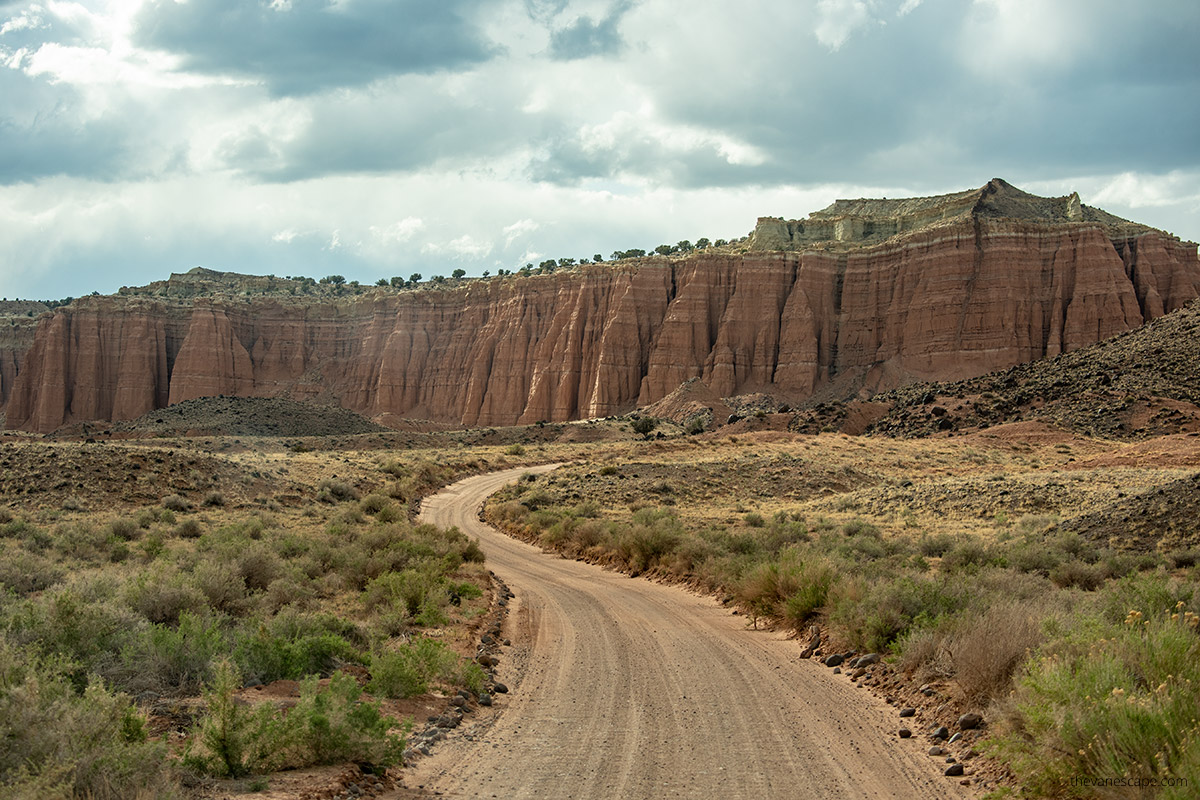
Frequently Asked Questions about Cathedral Valley Loop
How long does it take to complete the Cathedral Valley Loop?
The loop itself takes about 6-8 hours to complete without stops. However, if you plan to hike or take photographs, it’s best to allocate a full day.
Is a 4WD vehicle necessary?
A high-clearance 4WD vehicle is strongly recommended due to the rugged and sometimes sandy or muddy conditions.
Are there any gas stations along the loop?
No, there are no gas stations along the Cathedral Valley Loop. The nearest gas stations are in Torrey or Hanksville, so make sure to fill up before you start.
Is it safe to drink water from streams or rivers?
Drinking water from natural sources without treating it first is not advisable due to the risk of waterborne diseases.
Can I camp anywhere in Cathedral Valley?
While Cathedral Valley Campground is the primary camping spot, dispersed camping is also allowed in certain areas, but only with a free backcountry permit.
What’s the best time to visit for photography?
The golden hour—shortly after sunrise and before sunset—is generally considered the best time for photography in Cathedral Valley.
Is Cathedral Valley Loop open year-round?
Yes, but accessibility can be affected by weather conditions, especially during the winter and monsoon seasons. Always check the latest weather and road conditions before your trip.
Are pets allowed?
Pets are allowed only on roads and in designated campgrounds. They are not allowed on hiking trails.
Is there a fee to enter Cathedral Valley?
There is no separate fee for Cathedral Valley, but you will need to pay the Capitol Reef National Park entrance fee.
What should I do in case of an emergency?
In case of an emergency, dial 911. However, be aware that cell service is extremely limited. It’s advisable to carry a satellite phone or emergency beacon. Before you go, ask the visitor center about river ford conditions or call 435-425-3791.
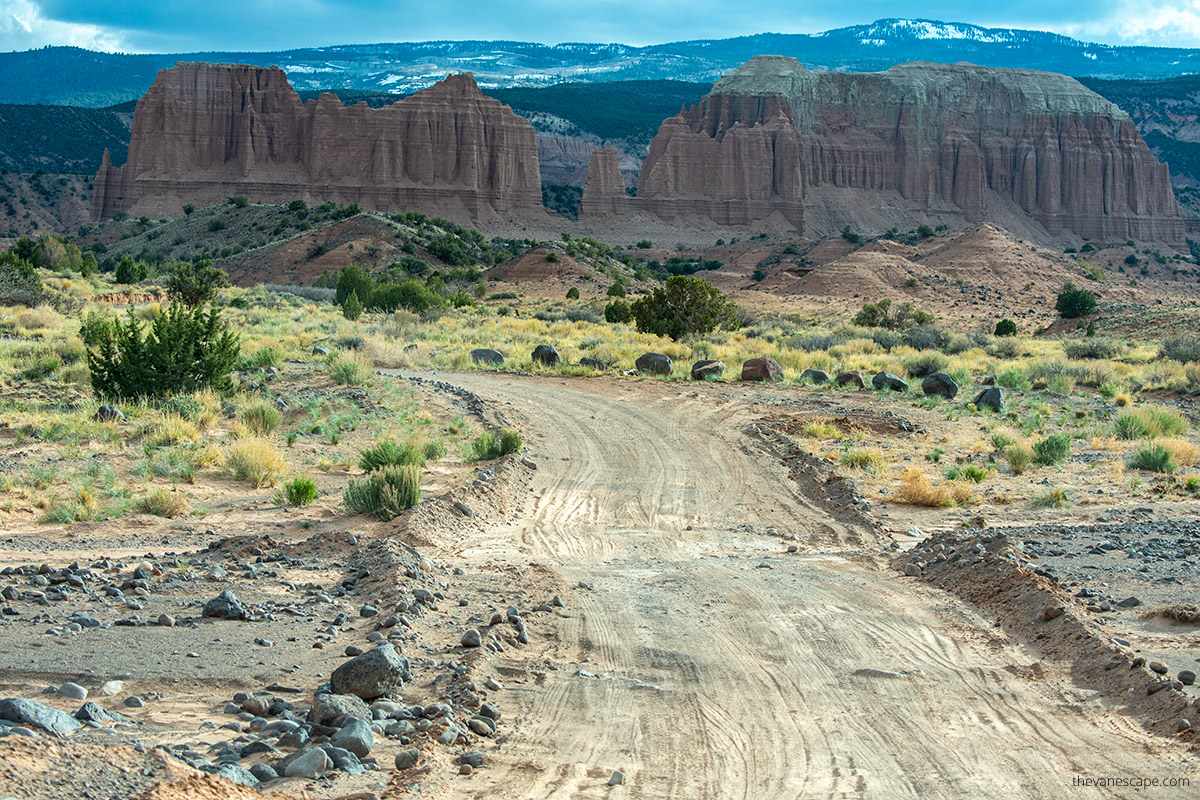
Plan a trip to Capitol Reef National Park? Check Related Articles:
- Capitol Reef National Park – How to Plan a Trip?
- Things to do in Capitol Reef National Park
- Hickman Bridge Hike
- Capitol Reef National Park Itinerary
- Tips for Exploring Factory Butte in Utah
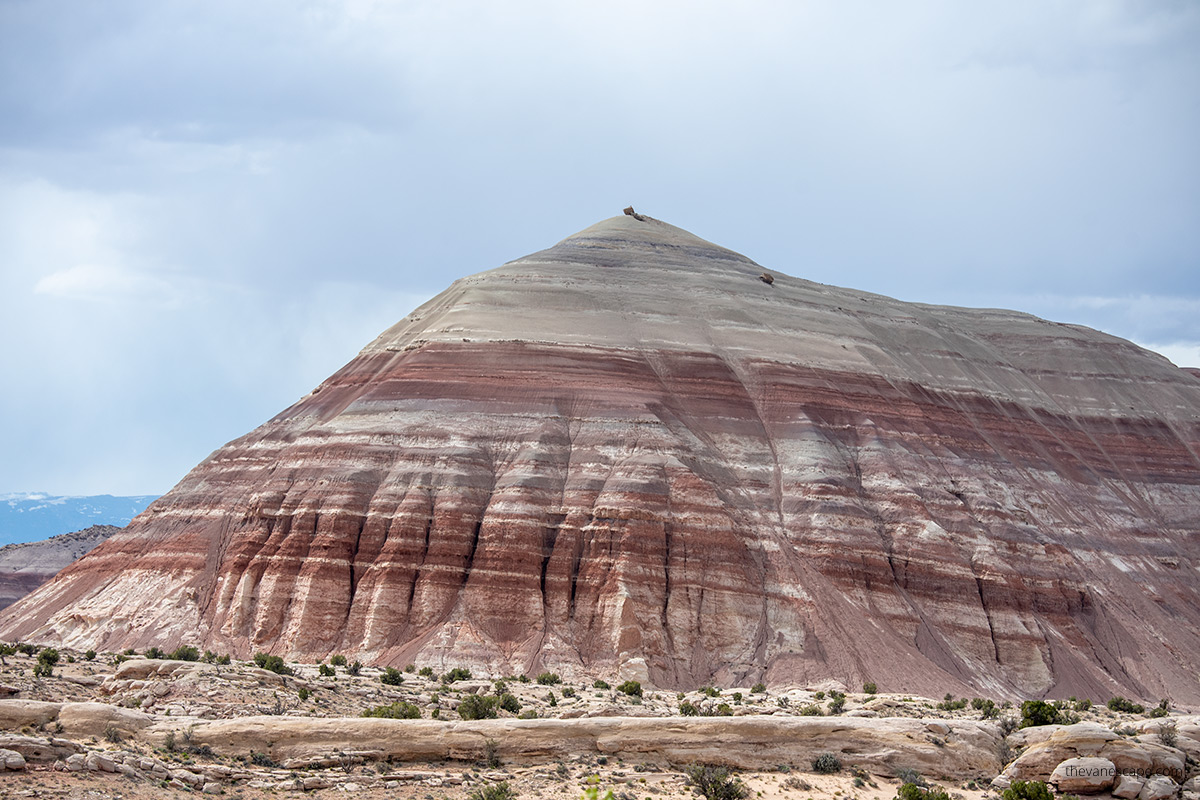
Conclusion: Why Cathedral Valley Loop is a Must-Visit
In summary, Cathedral Valley Loop is not just a drive; it’s a journey through some of Utah’s most awe-inspiring landscapes. From the towering Temple of the Sun and Temple of the Moon to the vibrant Bentonite Hills, this loop offers an unparalleled blend of natural beauty, adventure, and solitude.
Let’s be clear: Cathedral Valley Loop is the definitive choice if you’re seeking an authentic Utah backcountry experience. It’s a place where every turn in the road presents a new photographic opportunity, and every trail leads to geological wonders millions of years in the making.
The #1 Tip: Preparation is Key
As we emphasized in our insider tips, preparation is crucial for this adventure. A well-prepared trip with the right vehicle, supplies, and awareness of weather conditions will enhance your experience and ensure your safety.
Cathedral Valley is a sanctuary of solitude in an age where popular tourist spots are often overcrowded. It’s the perfect antidote for those feeling the stress and constant buzz of modern life, offering a rare chance to unplug, unwind, and connect deeply with nature.
Visiting Cathedral Valley is also a commitment to responsible tourism. By adhering to Leave No Trace principles, you’re doing your part to ensure this magnificent landscape remains pristine for future generations.
In no uncertain terms, Cathedral Valley Loop is an absolute must-visit. It’s an adventure that challenges you, a landscape that captivates you, and a journey that stays long after you return home.
Do You Like It? Pin It For Later!
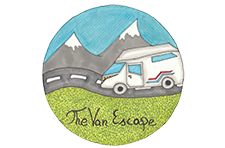
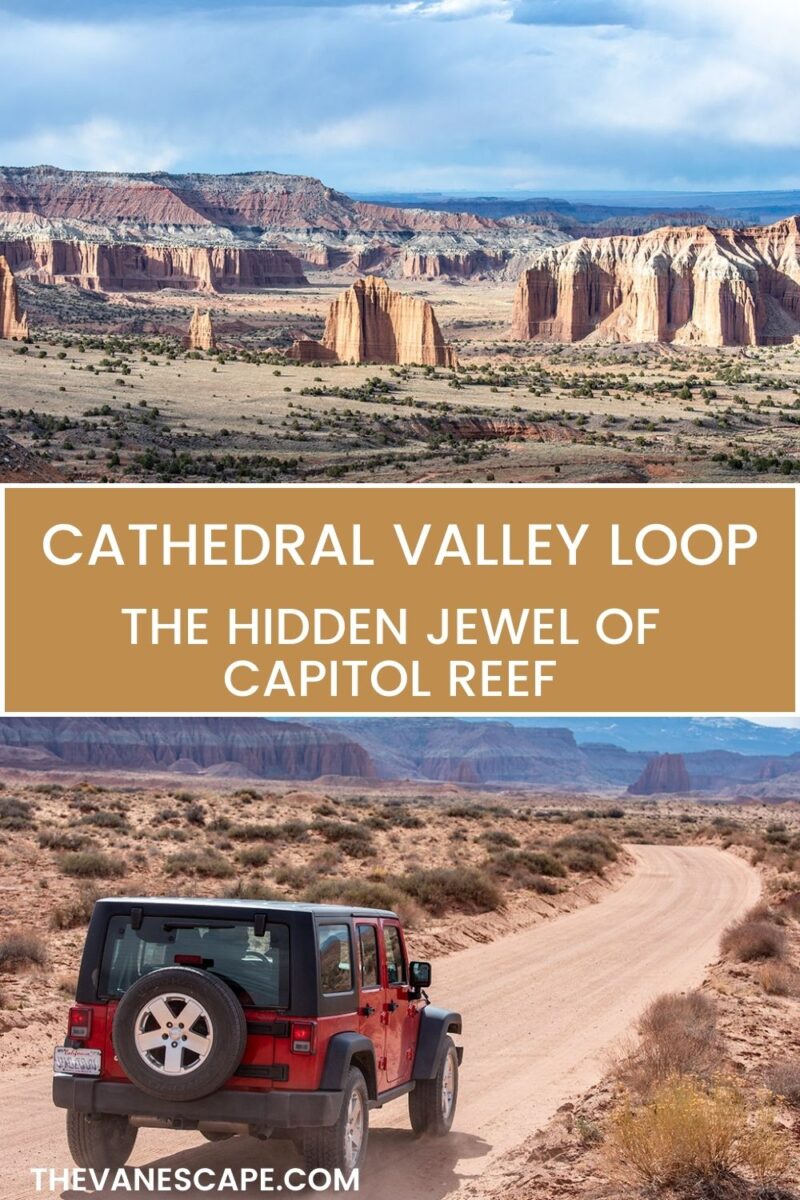
Already as I saw the first picture, my jaw dropped and my heart skipped a beat: There are truly surreal places on planet Earth, and you guys seem to find them all 🙂 Then, as I read your comprehensive and detailed post where you seem to consider each and every aspect of a tour and prepare your readers like a pair of online guardian angels is just amazing. By sharing all your experience and expertise, you take your readers by the hand without sounding patronizing. It’s evident that you want your readers to have the same wonderful experience you had, and that’s lovely and generous.
A wonderful guide to a wonderful place!
You guys are awesome! I can feel the fun you both have in your writing, much appreciated both in inspiration and information thank you!
http://semaglupharm.com/# Semaglu Pharm
LipiPharm: best time to take lipitor pills – LipiPharm
Predni Pharm [url=https://prednipharm.shop/#]Predni Pharm[/url] where can i buy prednisone
http://crestorpharm.com/# Buy statins online discreet shipping
https://semaglupharm.com/# 7mg rybelsus
CrestorPharm: Best price for Crestor online USA – what time of day should i take crestor
buy prednisone 40 mg [url=https://prednipharm.com/#]buy prednisone mexico[/url] PredniPharm
https://semaglupharm.com/# SemagluPharm
2.5 mg prednisone daily: prednisone 20 mg – prednisone 25mg from canada
prednisone over the counter south africa: PredniPharm – prednisone 10mg tabs
LipiPharm [url=https://lipipharm.shop/#]Lipi Pharm[/url] Atorvastatin online pharmacy
https://prednipharm.com/# drug prices prednisone
https://semaglupharm.shop/# SemagluPharm
lipitor and vitamin d: LipiPharm – lipitor 20 mg tablet
Safe online pharmacy for Crestor: Crestor Pharm – Affordable cholesterol-lowering pills
LipiPharm [url=https://lipipharm.shop/#]LipiPharm[/url] Lipi Pharm
https://semaglupharm.com/# can semaglutide cause anxiety
Semaglu Pharm: Safe delivery in the US – what does compounded semaglutide mean
Lipi Pharm: LipiPharm – clopidogrel and atorvastatin
Crestor home delivery USA [url=http://crestorpharm.com/#]CrestorPharm[/url] Crestor 10mg / 20mg / 40mg online
http://semaglupharm.com/# Semaglu Pharm
https://semaglupharm.com/# SemagluPharm
No RX Lipitor online: LipiPharm – Lipi Pharm
https://semaglupharm.shop/# semaglutide results 4 weeks
can you buy prednisone in canada: Predni Pharm – where to buy prednisone in australia
LipiPharm: FDA-approved generic statins online – Lipi Pharm
http://semaglupharm.com/# SemagluPharm
Predni Pharm: PredniPharm – where can i buy prednisone
Semaglu Pharm [url=https://semaglupharm.shop/#]how to give semaglutide injection in thigh[/url] Rybelsus online pharmacy reviews
https://semaglupharm.shop/# Semaglu Pharm
Lipi Pharm: Lipi Pharm – Lipi Pharm
https://semaglupharm.com/# FDA-approved Rybelsus alternative
Semaglu Pharm [url=https://semaglupharm.shop/#]Semaglu Pharm[/url] does semaglutide cause anxiety
Online statin drugs no doctor visit: atorvastatin grapefruit – Lipi Pharm
CrestorPharm: CrestorPharm – rosuvastatin cause ed
https://semaglupharm.shop/# No prescription diabetes meds online
Predni Pharm [url=https://prednipharm.shop/#]Predni Pharm[/url] Predni Pharm
Semaglu Pharm: whats the difference between semaglutide and tirzepatide – Rybelsus online pharmacy reviews
Lipi Pharm: LipiPharm – what drugs should not be taken with atorvastatin
http://prednipharm.com/# how much is prednisone 5mg
https://semaglupharm.com/# diabetes drug rybelsus
SemagluPharm [url=https://semaglupharm.shop/#]Semaglu Pharm[/url] how to take rybelsus 3 mg
Cheap Lipitor 10mg / 20mg / 40mg: Lipi Pharm – LipiPharm
https://semaglupharm.com/# half life of semaglutide
Lipi Pharm: LipiPharm – lipitor dosage range
п»їBuy Crestor without prescription [url=https://crestorpharm.shop/#]CrestorPharm[/url] CrestorPharm
SemagluPharm: Semaglu Pharm – Rybelsus side effects and dosage
https://semaglupharm.com/# SemagluPharm
Lipi Pharm: Lipi Pharm – Generic Lipitor fast delivery
https://semaglupharm.com/# SemagluPharm
Predni Pharm [url=https://prednipharm.com/#]PredniPharm[/url] prednisone
SemagluPharm: Where to buy Semaglutide legally – can i take berberine and semaglutide together
http://semaglupharm.com/# how much rybelsus for weight loss
CrestorPharm: CrestorPharm – rosuvastatin make you sleepy
India Pharm Global [url=https://indiapharmglobal.com/#]Online medicine home delivery[/url] indian pharmacy
best canadian pharmacy online: safe reliable canadian pharmacy – certified canadian pharmacy
https://canadapharmglobal.com/# buying drugs from canada
India Pharm Global: indian pharmacy – indian pharmacy
https://canadapharmglobal.shop/# canadian online drugs
india online pharmacy [url=https://indiapharmglobal.shop/#]top 10 pharmacies in india[/url] indian pharmacies safe
reputable mexican pharmacies online: medication from mexico pharmacy – Meds From Mexico
best online pharmacy india: India Pharm Global – India Pharm Global
https://indiapharmglobal.shop/# India Pharm Global
canadian pharmacy drugs online [url=http://canadapharmglobal.com/#]online canadian drugstore[/url] canadian online drugs
reputable mexican pharmacies online: Meds From Mexico – mexican drugstore online
Meds From Mexico: Meds From Mexico – п»їbest mexican online pharmacies
http://canadapharmglobal.com/# ed meds online canada
http://medsfrommexico.com/# Meds From Mexico
Meds From Mexico [url=https://medsfrommexico.shop/#]mexico drug stores pharmacies[/url] Meds From Mexico
india online pharmacy: India Pharm Global – India Pharm Global
best canadian pharmacy: canadian world pharmacy – online canadian pharmacy review
https://canadapharmglobal.com/# canadian pharmacy uk delivery
India Pharm Global [url=http://indiapharmglobal.com/#]online pharmacy india[/url] India Pharm Global
reputable mexican pharmacies online: Meds From Mexico – medicine in mexico pharmacies
http://canadapharmglobal.com/# canadian pharmacy price checker
india online pharmacy: top 10 online pharmacy in india – cheapest online pharmacy india
http://medsfrommexico.com/# Meds From Mexico
п»їlegitimate online pharmacies india: India Pharm Global – indian pharmacy online
mexico drug stores pharmacies [url=https://medsfrommexico.shop/#]purple pharmacy mexico price list[/url] buying prescription drugs in mexico
India Pharm Global: indianpharmacy com – India Pharm Global
http://indiapharmglobal.com/# online shopping pharmacy india
Meds From Mexico: reputable mexican pharmacies online – Meds From Mexico
canadian drug prices [url=https://canadapharmglobal.shop/#]Canada Pharm Global[/url] northwest canadian pharmacy
https://medsfrommexico.shop/# Meds From Mexico
India Pharm Global: india pharmacy mail order – India Pharm Global
buy prescription drugs from canada cheap: the canadian drugstore – canadian pharmacy 24
Meds From Mexico [url=https://medsfrommexico.com/#]Meds From Mexico[/url] Meds From Mexico
https://indiapharmglobal.com/# buy prescription drugs from india
mexican border pharmacies shipping to usa: Meds From Mexico – Meds From Mexico
india pharmacy: India Pharm Global – India Pharm Global
https://canadapharmglobal.shop/# pharmacy canadian superstore
Meds From Mexico [url=https://medsfrommexico.com/#]Meds From Mexico[/url] Meds From Mexico
https://medsfrommexico.shop/# mexican drugstore online
maple leaf pharmacy in canada: canada ed drugs – legitimate canadian pharmacy
qual ГЁ la farmacia online piГ№ affidabile? [url=https://efarmaciait.com/#]EFarmaciaIt[/url] EFarmaciaIt
EFarmaciaIt: farmacia spedizione gratuita 29 euro – amazon daflon 500 120 compresse
https://efarmaciait.com/# EFarmaciaIt
pillola klaira costo: dr. max recensioni – EFarmaciaIt
http://raskapotek.com/# Rask Apotek
apotek symbol [url=https://svenskapharma.shop/#]Svenska Pharma[/url] alunstift apotek
https://raskapotek.shop/# Rask Apotek
bestГ¤lla nytt recept: Svenska Pharma – hur stavas 40
prickmottagning apotek: Svenska Pharma – spotek
https://papafarma.com/# Papa Farma
farmacia costano [url=https://efarmaciait.shop/#]EFarmaciaIt[/url] farmacie spedizione gratuita
Rask Apotek: Rask Apotek – l serin apotek
https://raskapotek.shop/# Rask Apotek
hГ¤mta covidtest pГҐ apotek: Svenska Pharma – Svenska Pharma
https://efarmaciait.com/# EFarmaciaIt
sminkefjerner apotek [url=https://raskapotek.com/#]Rask Apotek[/url] Rask Apotek
https://efarmaciait.com/# farmacia l
Rask Apotek: test cГёliaki apotek – Rask Apotek
dodot sensitive talla 4 plus [url=https://papafarma.com/#]comprar cialis online opiniones[/url] oral b io 7 duo
farmacia sevilla cerca de mi: farmacia inline – Papa Farma
https://svenskapharma.shop/# Svenska Pharma
https://raskapotek.shop/# ГҐpent apotek i pГҐsken
siti farmacia con spedizione gratuita: EFarmaciaIt – EFarmaciaIt
Svenska Pharma [url=https://svenskapharma.shop/#]bästa ashwagandha[/url] apotek sweden
https://svenskapharma.com/# Svenska Pharma
apotek ГҐpent sГёndag: loppefrГё apotek – aotek
hyaluronsyre apotek: Rask Apotek – apotek proteinpulver
apotek leverans samma dag [url=http://svenskapharma.com/#]Svenska Pharma[/url] Svenska Pharma
https://efarmaciait.shop/# 1000 farmacia
parafarmacia barata online: Papa Farma – Papa Farma
ice pack apotek: Svenska Pharma – Svenska Pharma
vimovo genГ©rico [url=https://papafarma.com/#]farmacia 24h murcia[/url] cuanto cuesta una farmacia en espaГ±a
https://papafarma.shop/# Papa Farma
EFarmaciaIt: EFarmaciaIt – EFarmaciaIt
EFarmaciaIt: EFarmaciaIt – EFarmaciaIt
farmacia via parque [url=http://papafarma.com/#]Papa Farma[/url] framacia online
http://svenskapharma.com/# Svenska Pharma
Papa Farma: farma boutique – Papa Farma
tadalafil 20 mg precio: farmcia – venta online farmacia
http://efarmaciait.com/# dymista spray nasale prezzo mutuabile
https://papafarma.com/# Papa Farma
Papa Farma [url=http://papafarma.com/#]farmacia oline[/url] traspaso farmacia madrid
narkotika test apotek: panthenol apotek – Rask Apotek
hurtigtest korona apotek: varmepute med ris apotek – beste nettapotek
https://papafarma.com/# Papa Farma
brufen 600 composizione [url=http://efarmaciait.com/#]EFarmaciaIt[/url] EFarmaciaIt
Rask Apotek: covid vaksine pГҐ apotek – Rask Apotek
http://efarmaciait.com/# EFarmaciaIt
https://efarmaciait.shop/# selgamis crema a cosa serve
Rask Apotek [url=http://raskapotek.com/#]tГҐskiller apotek[/url] inngrodd tГҐnegl apotek
pillola cerazette prezzo: esteclin sciroppo – nicetile generico
shop apotheke online bestellen [url=https://pharmajetzt.shop/#]medikamente corona apotheke[/url] Pharma Jetzt
Pharma Confiance: Pharma Confiance – parapharmacie la moins chГЁre de paris
https://pharmaconnectusa.shop/# online pharmacy products
PharmaConnectUSA: robaxin online pharmacy – sumatriptan uk pharmacy
http://pharmaconfiance.com/# exemple ordonnance bas de contention
Pharma Connect USA [url=https://pharmaconnectusa.shop/#]omeprazole pharmacy only[/url] doc morris pharmacy artane
https://pharmajetzt.com/# Pharma Jetzt
PharmaConnectUSA: bupropion sr online pharmacy – PharmaConnectUSA
betrouwbare online apotheek zonder recept: medicijn bestellen apotheek – online pharmacy nl
http://pharmajetzt.com/# PharmaJetzt
uk pharmacy viagra [url=https://pharmaconnectusa.shop/#]Pharma Connect USA[/url] spironolactone in house pharmacy
https://pharmajetzt.com/# Pharma Jetzt
apteka den haag: medicijn bestellen – mijn apotheek online
betrouwbare online apotheek zonder recept: Medicijn Punt – MedicijnPunt
https://pharmaconfiance.com/# Pharma Confiance
PharmaJetzt [url=https://pharmajetzt.shop/#]online aphoteke[/url] online apotheke kostenloser versand
online apotheek – gratis verzending: Medicijn Punt – apotheken nederland
PharmaConnectUSA: PharmaConnectUSA – PharmaConnectUSA
https://pharmaconfiance.shop/# Pharma Confiance
http://pharmaconfiance.com/# Pharma Confiance
buy accutane pharmacy: nizoral online pharmacy – united pharmacy cialis
Pharma Confiance [url=http://pharmaconfiance.com/#]Pharma Confiance[/url] tetrafolic pharmacie
apotheek medicijnen bestellen: MedicijnPunt – apotheek online nl
https://pharmaconfiance.com/# medicament tadalafil 10 mg
flagyl sirop: Pharma Confiance – ketoprofene sun
anabolic steroids online pharmacy reviews [url=http://pharmaconnectusa.com/#]PharmaConnectUSA[/url] Pharma Connect USA
Pharma Confiance: Pharma Confiance – Pharma Confiance
https://pharmaconnectusa.com/# how much does cialis cost at the pharmacy
global rx pharmacy irvine: india online pharmacy viagra – the best online pharmacy
https://medicijnpunt.shop/# pharmacy nl
kex rx pharmacy atchison ks [url=https://pharmaconnectusa.shop/#]Pharma Connect USA[/url] PharmaConnectUSA
MedicijnPunt: uw apotheek – MedicijnPunt
http://pharmaconfiance.com/# tapis absorbant chat
france gdp: tadalafil 20 mg prix en pharmacie – prix viagra 100 mg
sildenafil 50 mg durГ©e de l’effet [url=http://pharmaconfiance.com/#]Pharma Confiance[/url] rouen pharmacie
https://pharmaconnectusa.shop/# PharmaConnectUSA
achat viagra: parapharmacie test covid – amoxicilline et maux de tГЄte
sofort lieferung apotheke: apotheke online – gГјnstigste internetapotheke
meine online apotheke [url=https://pharmajetzt.com/#]PharmaJetzt[/url] Pharma Jetzt
http://medicijnpunt.com/# apotheek online nl
https://pharmaconnectusa.com/# spironolactone pharmacy
med apotheek: online apotheek nederland zonder recept – MedicijnPunt
viagra offshore pharmacy: PharmaConnectUSA – PharmaConnectUSA
MedicijnPunt [url=https://medicijnpunt.com/#]mijn medicijnkosten[/url] Medicijn Punt
http://pharmajetzt.com/# Pharma Jetzt
PharmaJetzt: PharmaJetzt – apotheke obline
Medicijn Punt: MedicijnPunt – apotheek winkel 24 review
https://pharmajetzt.com/# PharmaJetzt
mijn medicijnkosten [url=https://medicijnpunt.com/#]Medicijn Punt[/url] online apotheek zonder recept ervaringen
http://pharmaconnectusa.com/# PharmaConnectUSA
value rx pharmacy tazewell tn: online pharmacy no presc uk – PharmaConnectUSA
Pharma Jetzt: internetapotheken – Pharma Jetzt
http://pharmaconfiance.com/# Pharma Confiance
buy naltrexone from trusted pharmacy [url=https://pharmaconnectusa.shop/#]wal mart store pharmacy[/url] viagra reputable online pharmacy
spf rouen: Pharma Confiance – Pharma Confiance
apotheke onlin: Pharma Jetzt – Pharma Jetzt
http://pharmaconnectusa.com/# best online pharmacy generic cialis
Pharma Jetzt [url=https://pharmajetzt.shop/#]welche online apotheke ist am gГјnstigsten[/url] PharmaJetzt
Pharma Confiance: Pharma Confiance – caudalie contact
https://medicijnpunt.shop/# online medicatie bestellen
europese apotheek: online medicijnen – MedicijnPunt
http://pharmaconfiance.com/# Pharma Confiance
silicium organique g5 en pharmacie [url=https://pharmaconfiance.com/#]Pharma Confiance[/url] les 10 marques de rhum les plus vendus
pharmacie paris 13: quelle est la pharmacie de garde aujourd’hui Г strasbourg – Pharma Confiance
mijn apotheek medicijnen: Medicijn Punt – betrouwbare online apotheek zonder recept
https://pharmajetzt.com/# PharmaJetzt
versandapotheken in deutschland [url=https://pharmajetzt.shop/#]Pharma Jetzt[/url] Pharma Jetzt
MedicijnPunt: Medicijn Punt – Medicijn Punt
https://pharmaconfiance.com/# Pharma Confiance
MedicijnPunt: recepta online – MedicijnPunt
https://pharmaconnectusa.shop/# PharmaConnectUSA
Pharma Confiance [url=https://pharmaconfiance.com/#]Pharma Confiance[/url] chez dГ©dГ©
https://pharmajetzt.shop/# Pharma Jetzt
apptheke online: PharmaJetzt – PharmaJetzt
MedicijnPunt: recepta online – apotheker online
schopapoteke [url=https://pharmajetzt.com/#]medikamente ohne rezept bestellen[/url] luidpold apotheke
https://medicijnpunt.shop/# pharma apotheek
apotheje online: Pharma Jetzt – Pharma Jetzt
mijn medicijn bestellen: medicijnen apotheek – MedicijnPunt
http://pharmajetzt.com/# online apo
PharmaConnectUSA [url=http://pharmaconnectusa.com/#]Pharma Connect USA[/url] inderal pharmacy
https://pharmaconnectusa.com/# kamagra online pharmacy
newpharma mon panier: pharmacie homГ©opathie paris 16 – Pharma Confiance
MedicijnPunt: holandia apteka internetowa – MedicijnPunt
PharmaJetzt [url=https://pharmajetzt.com/#]online apotek[/url] medikamente
Pharma Jetzt: Pharma Jetzt – PharmaJetzt
versandapotheke ohne versandkosten: versandapotheken online – shop spotheke
http://pharmaconnectusa.com/# asacol pharmacy card
shop apotheken online [url=https://pharmajetzt.com/#]shop apptheke[/url] Pharma Jetzt
https://pharmajetzt.com/# internet apotheke
MedicijnPunt: Medicijn Punt – online medicijnen bestellen met recept
Pharma Confiance: boutique lourdes en ligne – Pharma Confiance
medicijnen online bestellen [url=https://medicijnpunt.com/#]Medicijn Punt[/url] MedicijnPunt
https://pharmajetzt.com/# online shop apotheke
orlistat online pharmacy uk: medical pharmacies – PharmaConnectUSA
Pharma Confiance: Pharma Confiance – Pharma Confiance
https://pharmaconnectusa.shop/# cheap online pharmacy
http://pharmaconfiance.com/# Pharma Confiance
MedicijnPunt [url=https://medicijnpunt.com/#]holland apotheke[/url] apotheek spanje online
Pharma Confiance: Pharma Confiance – Pharma Confiance
34 cl en gramme: Pharma Confiance – Pharma Confiance
Pharma Connect USA: live pharmacy continuing education online – PharmaConnectUSA
http://pharmajetzt.com/# PharmaJetzt
Pharma Confiance [url=https://pharmaconfiance.com/#]Pharma Confiance[/url] pharmacie dimanche caen
first medicine online pharmacy store: stokes pharmacy – Pharma Connect USA
http://pharmaconfiance.com/# Pharma Confiance
Medicijn Punt: medicatie bestellen – online apotheek gratis verzending
https://pharmajetzt.shop/# abotheke
versandapotheke vergleich: shop-apotheke online – Pharma Jetzt
Pharma Confiance [url=https://pharmaconfiance.com/#]jdd ventes[/url] parapharmacie boticinal
PharmaConnectUSA: PharmaConnectUSA – preferred plus pharmacy ibuprofen
PharmaConnectUSA: PharmaConnectUSA – 24 hours pharmacy
http://pharmaconfiance.com/# Pharma Confiance
PharmaJetzt: PharmaJetzt – appotheke online
https://pharmajetzt.shop/# euro apotheke
Pharma Confiance: donner ddp 80 avis – Pharma Confiance
service apres vente ghd [url=http://pharmaconfiance.com/#]tadalafil medicament[/url] tapis d’entrГ©e absorbant professionnel
uw apotheek: Medicijn Punt – Medicijn Punt
https://pharmajetzt.com/# apotheke online günstig
sildenafil 100mg pharmacie en ligne: guigoz rose – Pharma Confiance
online medicine: shop-apotheke online – Pharma Jetzt
Pharma Jetzt [url=https://pharmajetzt.com/#]PharmaJetzt[/url] deutschland apotheke
https://pharmaconfiance.com/# biostime point de vente
Pharma Jetzt: Pharma Jetzt – Pharma Jetzt
https://pharmaconfiance.shop/# pharmacie ouverture 8h
Pharma Jetzt: onlineapothele – internet apotheke
Medicijn Punt: apteka internetowa holandia – farma online
Pharma Jetzt [url=https://pharmajetzt.shop/#]Pharma Jetzt[/url] Pharma Jetzt
apotheek inloggen: medicijnen zonder recept kopen – online apotheek recept
http://pharmaconnectusa.com/# Top Avana
Pharma Confiance: ggp auto montpellier – Pharma Confiance
acheter vaccin chat en ligne: fournisseur pharmaceutique – pharmacie de garde 34
http://pharmaconnectusa.com/# ed pills online
http://medicijnpunt.com/# Medicijn Punt
Pharma Jetzt [url=http://pharmajetzt.com/#]welche online apotheken gibt es[/url] PharmaJetzt
gd distribution: Pharma Confiance – Pharma Confiance
PharmaConnectUSA: pharmacy concept store – Pharma Connect USA
http://medicijnpunt.com/# Medicijn Punt
top 10 pharmacy websites: clozapine pharmacy registry – karns grocery store have a pharmacy?
medicijnen kopen: apteka internetowa nl – Medicijn Punt
apotheke internet [url=https://pharmajetzt.com/#]sjop apotheke[/url] PharmaJetzt
https://medicijnpunt.com/# belgische online apotheek
onlineapotheken: Pharma Jetzt – PharmaJetzt
https://pharmajetzt.com/# online apotheke versandkostenfrei
apteka nl online [url=https://medicijnpunt.com/#]viata online apotheek[/url] MedicijnPunt
gГјnstige arzneimittel: medikamente liefern lassen – lavita login
internet apotheken ohne versandkosten: PharmaJetzt – apotheke online kaufen
https://medicijnpunt.com/# apteka nl
Pharma Jetzt: sjop apotheke – online versandapotheke
mail order pharmacies: Pharma Connect USA – best ed medication
Pharma Confiance [url=http://pharmaconfiance.com/#]Pharma Confiance[/url] Г©chantillon gratuit bГ©bГ© pharmacie
https://pharmaconnectusa.com/# PharmaConnectUSA
medicijnen zonder recept: Medicijn Punt – MedicijnPunt
http://pharmaconfiance.com/# verveine constipation
Pharma Confiance: parapharmazen en ligne – Pharma Confiance
TijuanaMeds: mexico drug stores pharmacies – TijuanaMeds
canadian mail order pharmacy [url=https://canrxdirect.shop/#]canadianpharmacymeds com[/url] canadian pharmacy uk delivery
IndiMeds Direct: top online pharmacy india – indianpharmacy com
https://indimedsdirect.shop/# IndiMeds Direct
http://indimedsdirect.com/# IndiMeds Direct
purple pharmacy mexico price list: mexico drug stores pharmacies – mexican online pharmacies prescription drugs
TijuanaMeds [url=http://tijuanameds.com/#]TijuanaMeds[/url] TijuanaMeds
http://indimedsdirect.com/# IndiMeds Direct
Online medicine home delivery: india online pharmacy – IndiMeds Direct
buying prescription drugs in mexico: buying from online mexican pharmacy – TijuanaMeds
https://canrxdirect.shop/# canadian pharmacy sarasota
TijuanaMeds [url=https://tijuanameds.com/#]buying from online mexican pharmacy[/url] TijuanaMeds
https://indimedsdirect.shop/# indian pharmacy online
mexican border pharmacies shipping to usa: TijuanaMeds – buying from online mexican pharmacy
https://canrxdirect.shop/# buying from canadian pharmacies
mexico drug stores pharmacies [url=https://tijuanameds.shop/#]best online pharmacies in mexico[/url] TijuanaMeds
medication from mexico pharmacy: TijuanaMeds – TijuanaMeds
http://canrxdirect.com/# certified canadian international pharmacy
buying prescription drugs in mexico online [url=https://tijuanameds.shop/#]TijuanaMeds[/url] mexican rx online
https://tijuanameds.shop/# buying prescription drugs in mexico
IndiMeds Direct: online pharmacy india – IndiMeds Direct
https://indimedsdirect.com/# IndiMeds Direct
the canadian drugstore [url=https://canrxdirect.com/#]CanRx Direct[/url] canada drugs online
https://canrxdirect.shop/# canada pharmacy 24h
canadian pharmacy ltd: buy prescription drugs from canada cheap – best canadian online pharmacy
vipps canadian pharmacy: reddit canadian pharmacy – medication canadian pharmacy
IndiMeds Direct [url=https://indimedsdirect.shop/#]top 10 online pharmacy in india[/url] cheapest online pharmacy india
https://tijuanameds.com/# medication from mexico pharmacy
world pharmacy india: IndiMeds Direct – indianpharmacy com
IndiMeds Direct: IndiMeds Direct – online pharmacy india
http://tijuanameds.com/# TijuanaMeds